Arequipa, Peru
Peru’s Second City
Arequipa, Peru’s second city, is widely considered its most beautiful with ornate white stone buildings set against the backdrop of multiple volcanoes. The city is a cultural hub with indigenous artisans manufacturing goods from alpaca and vicuña wool. It’s recognized as the gastronomic center of Peru for its cuisine with local dishes and Peruvian classics. Located between the Andes Mountains and Pacific Coast, its year round temperate climate makes it a popular destination with cool nights and warm sunny days.
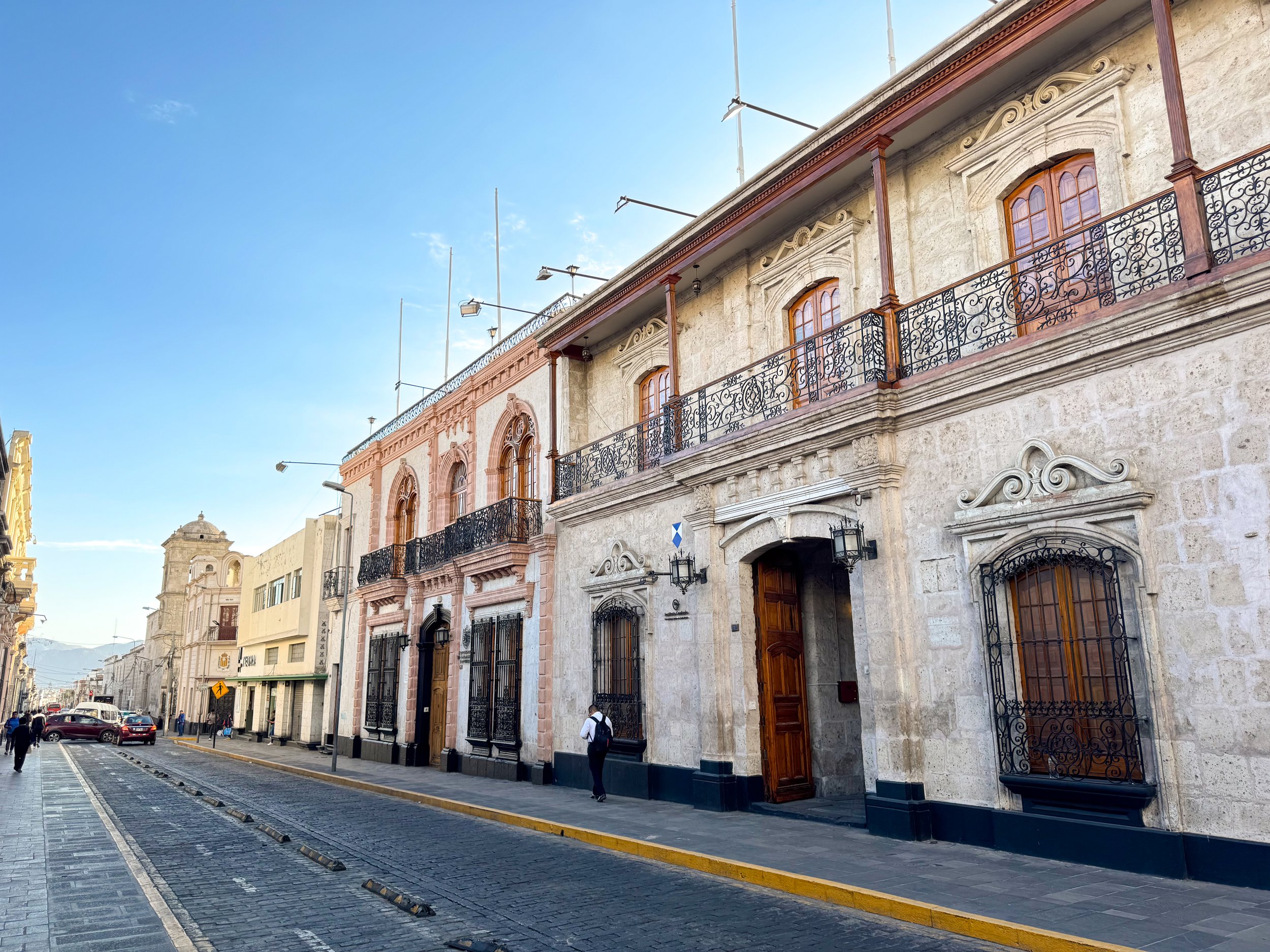
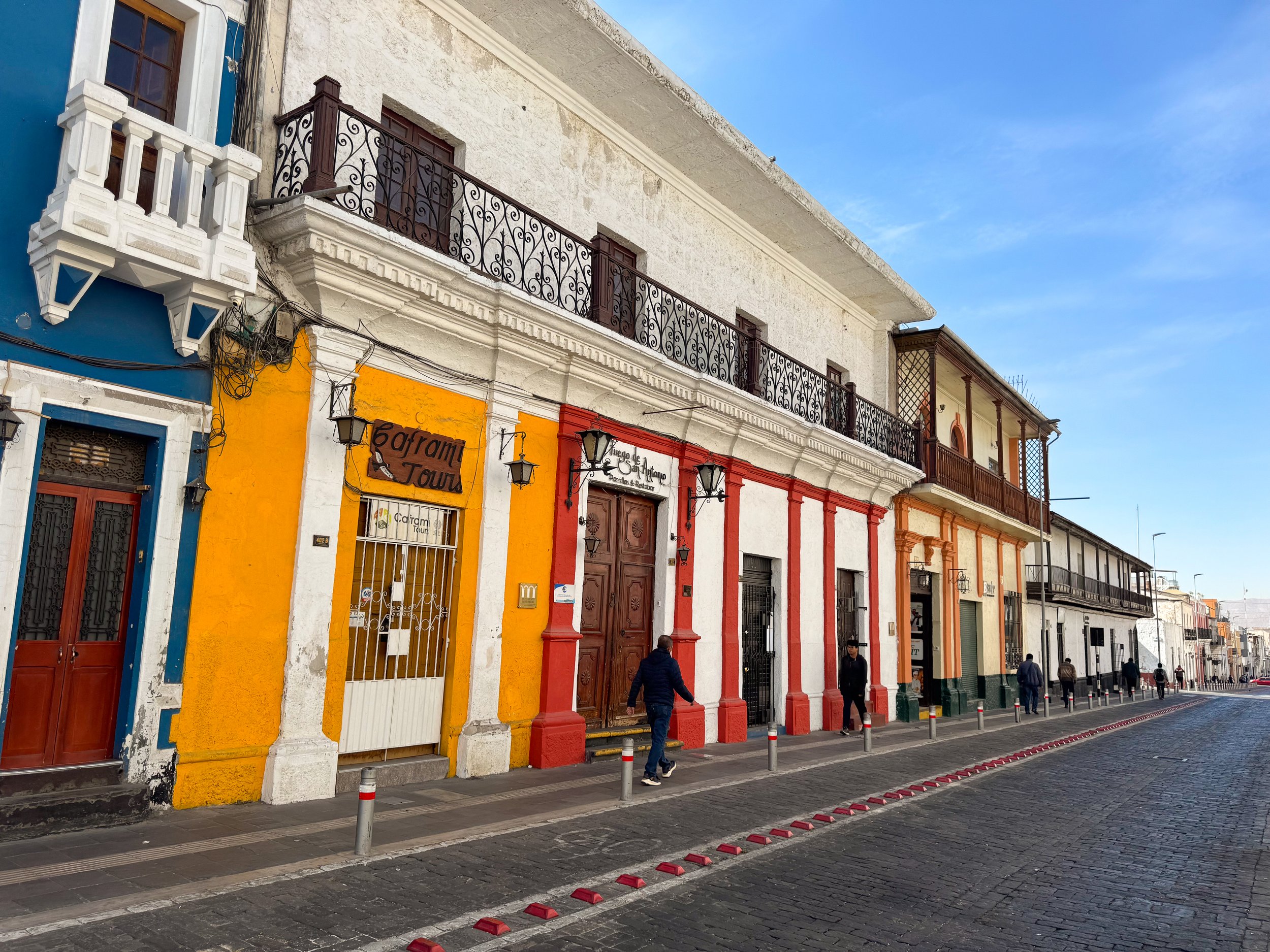
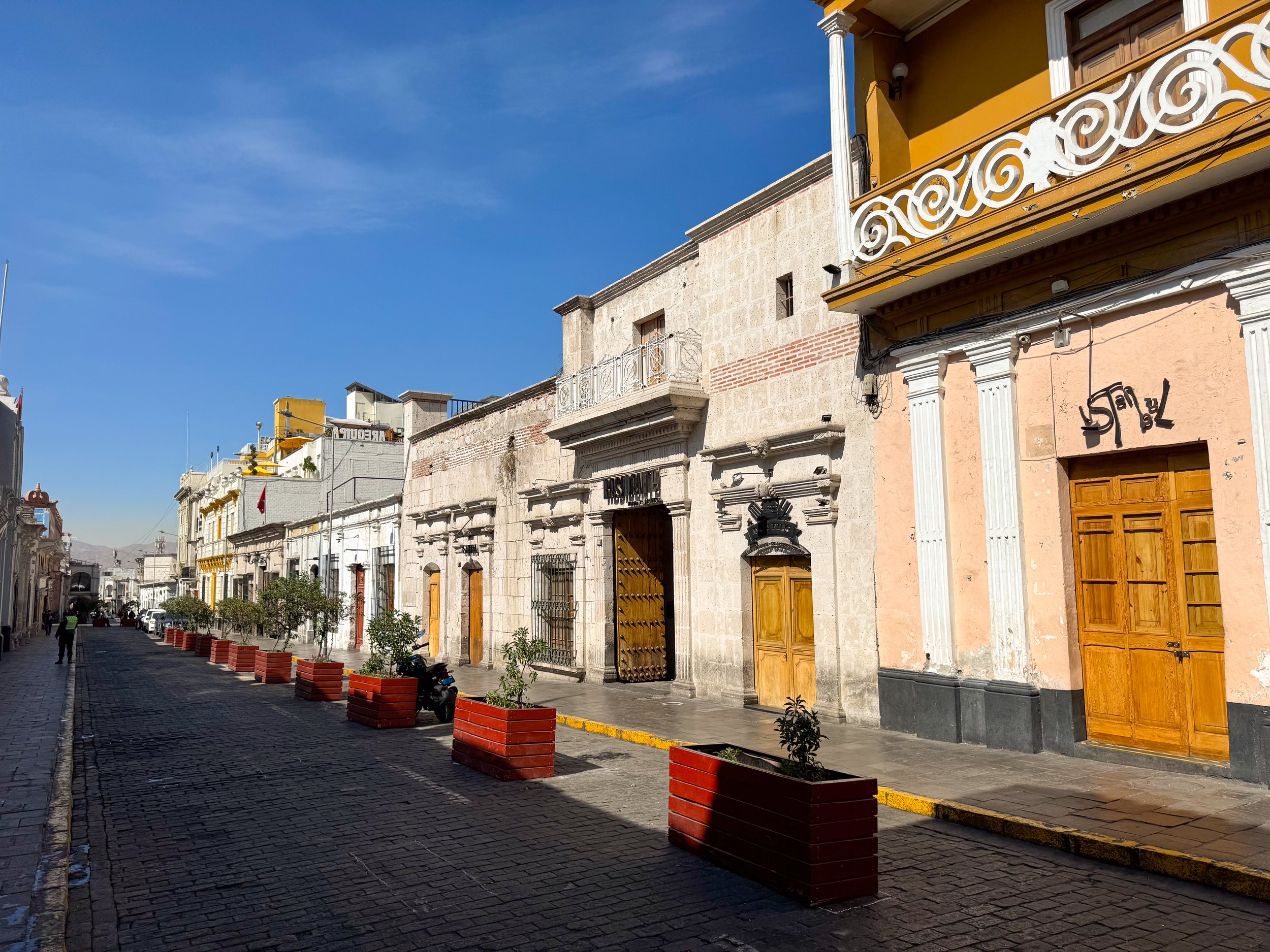
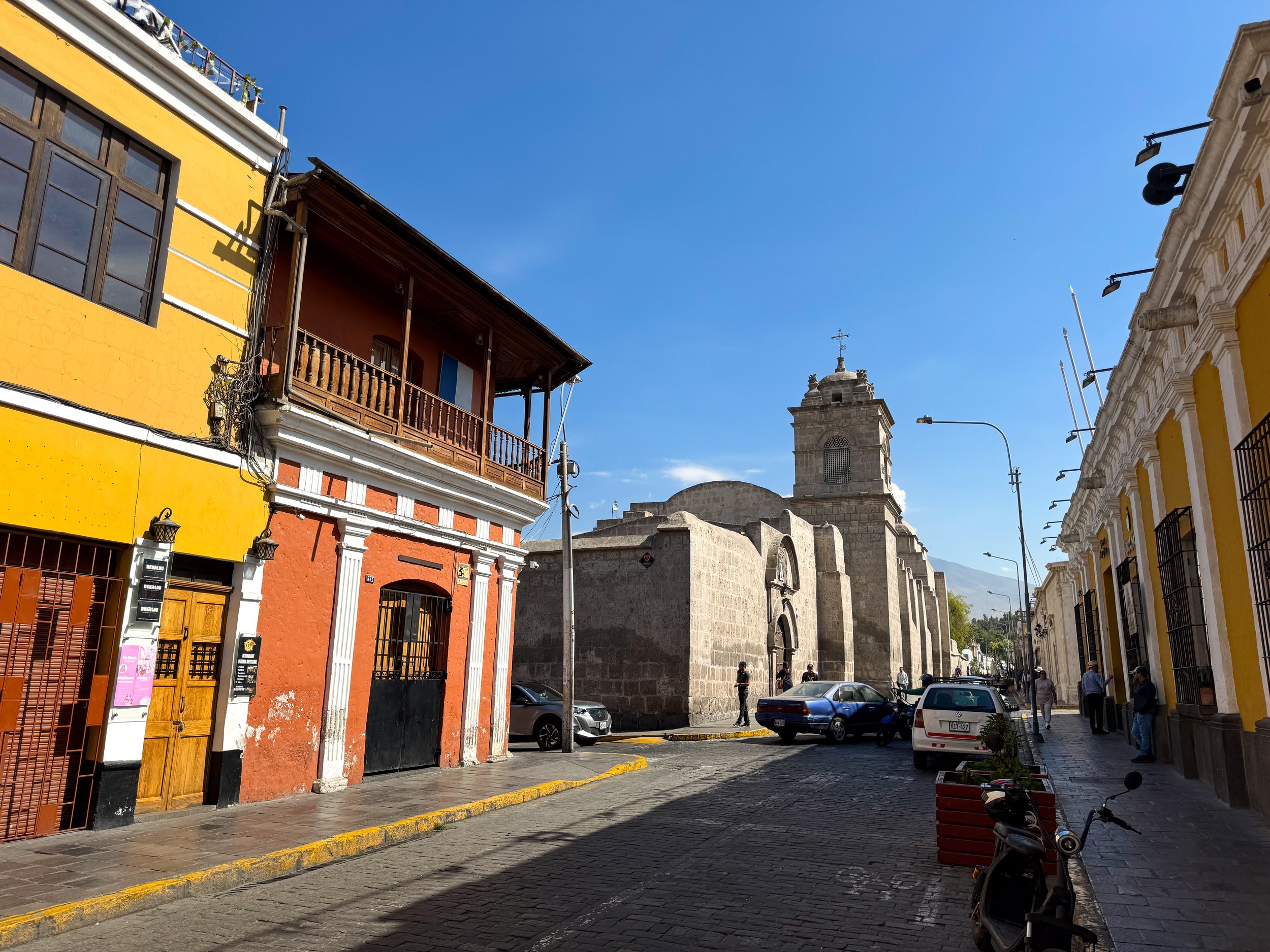
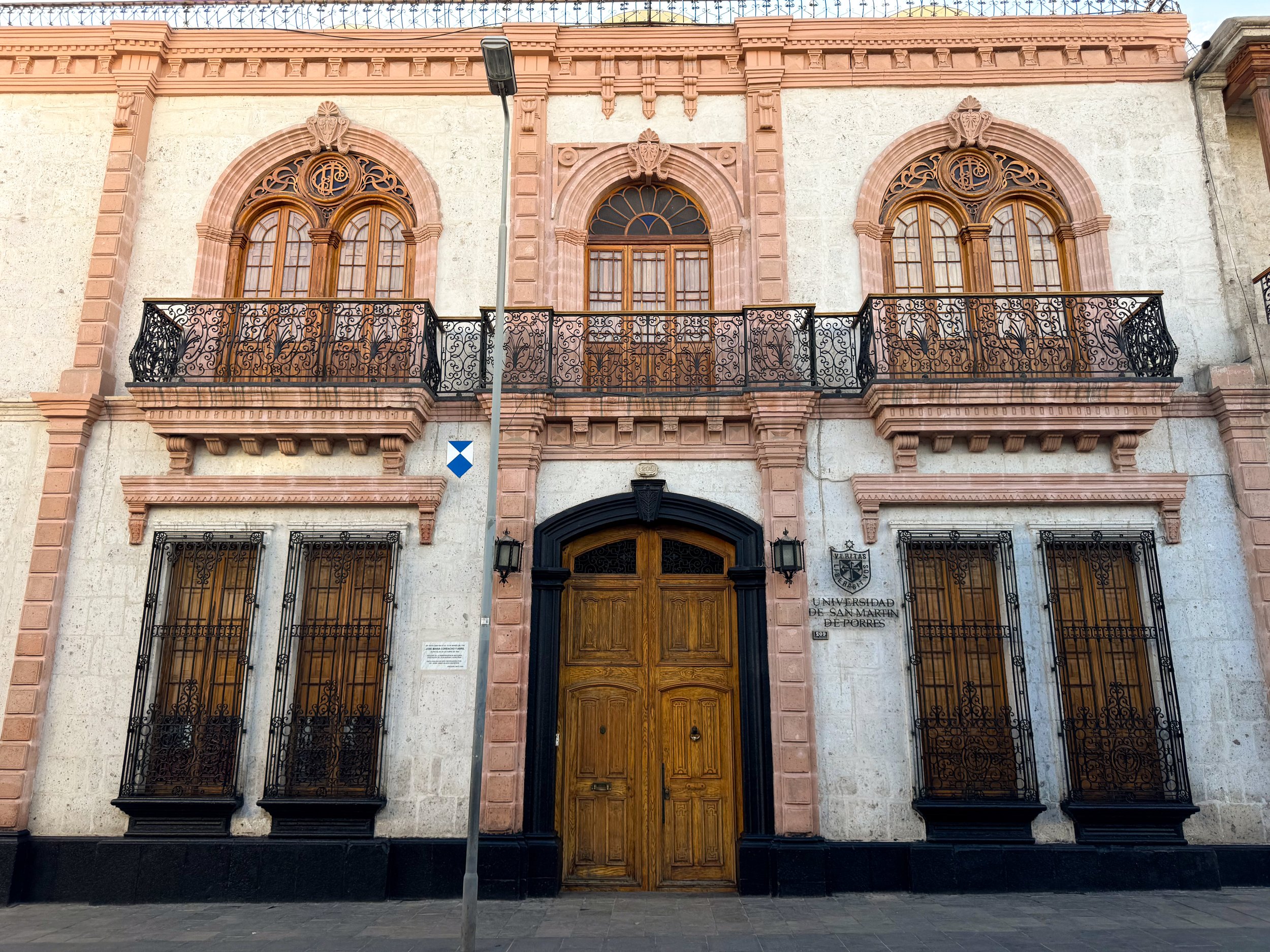
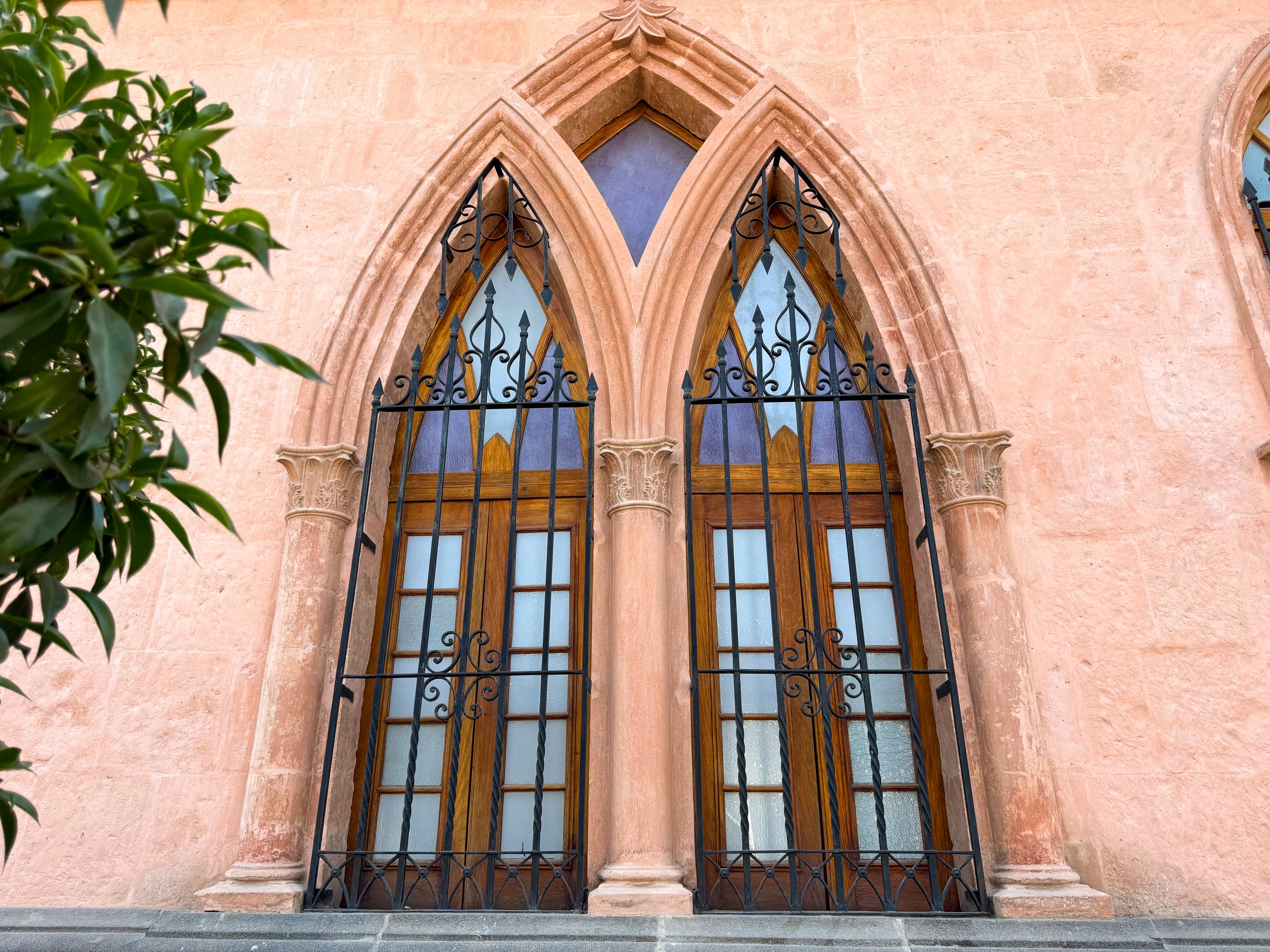
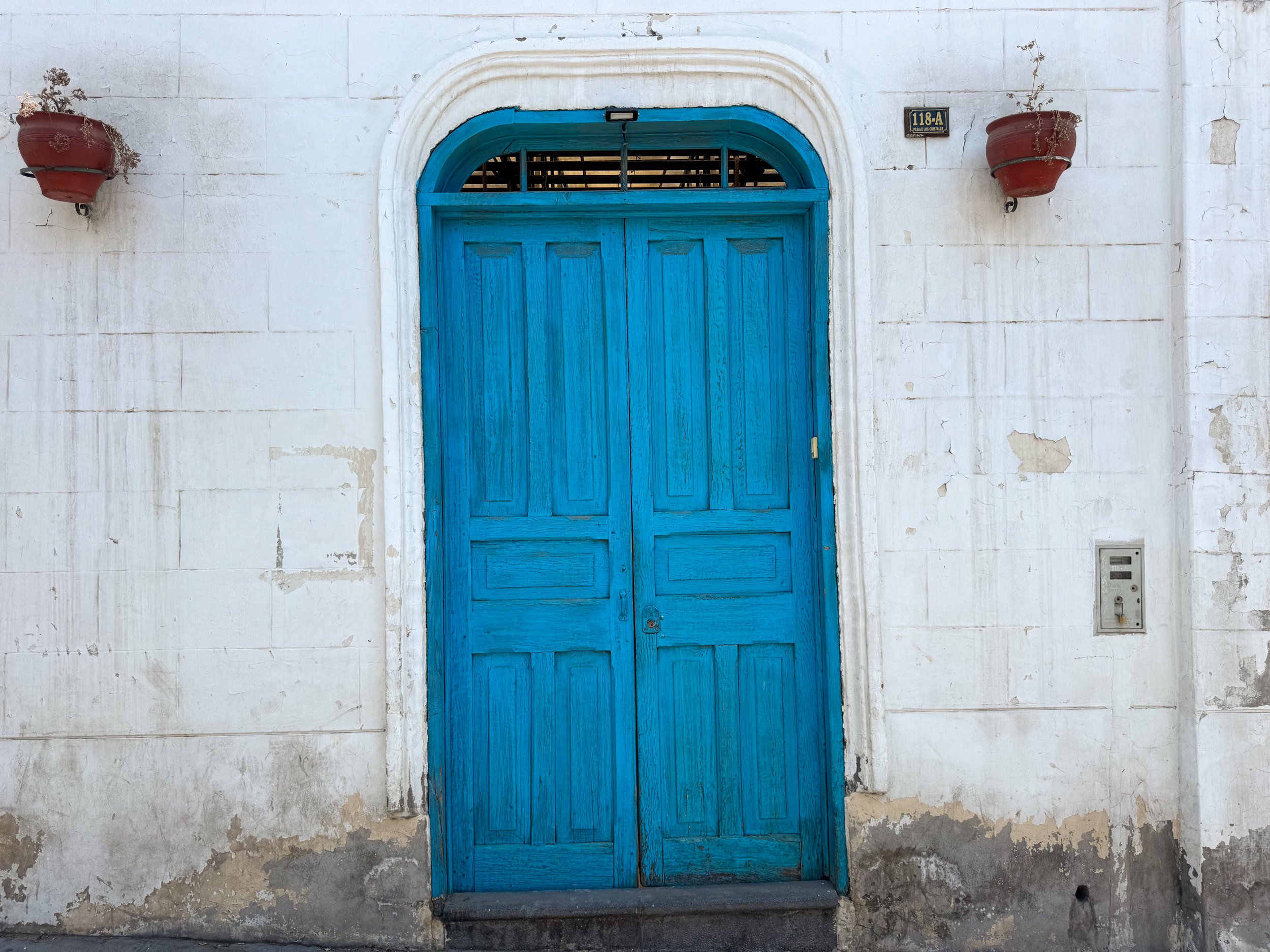
Neighborhoods & Streets
Centro Historico. The historic center of Arequipa centered on the Plaza de Armas with the largest collection of baroque style buildings, museums and landmark sights.
Lázaro Neighborhood. The oldest neighborhood in Arequipa with white stone walls, cobblestone streets and a small central plaza with cafes and bars.
Yanahuara Neighborhood. A neighborhood across the river from the Centro Historico with views overlooking the city and volcanos.
Calle Santa Catalina. A street through the Centro Historico with restaurants, cafes, bars and shops selling alpaca clothes and accessories.
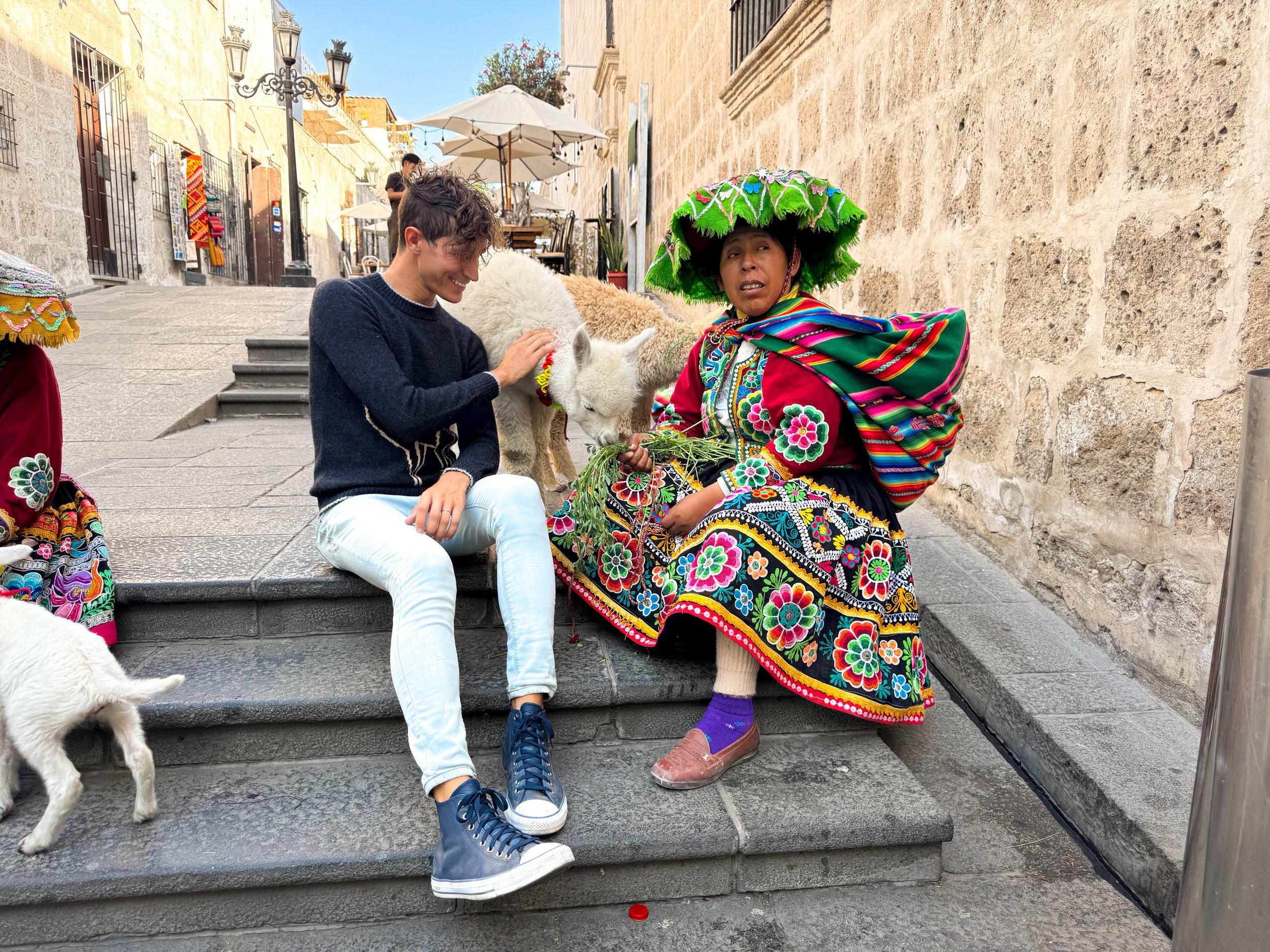
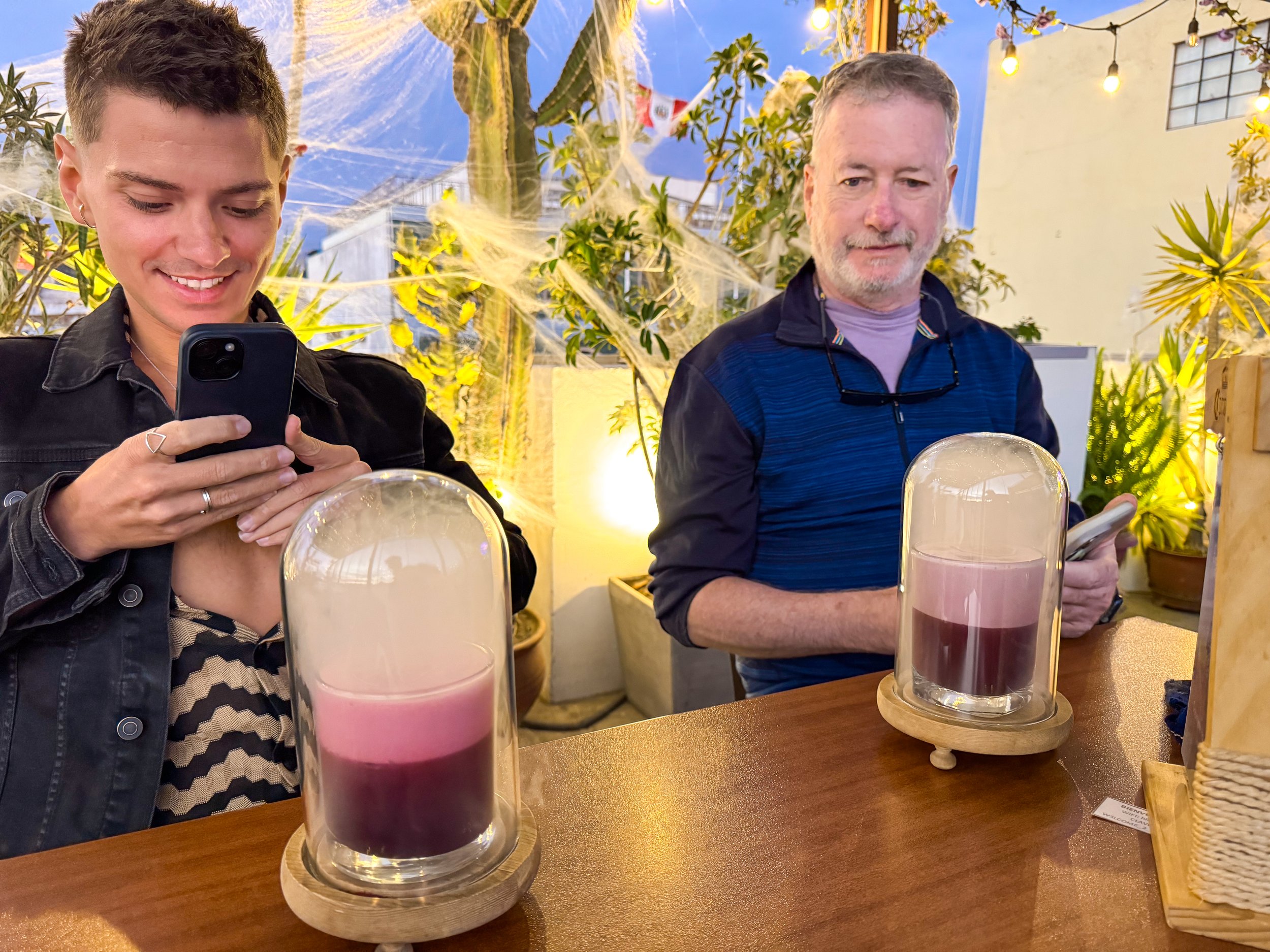
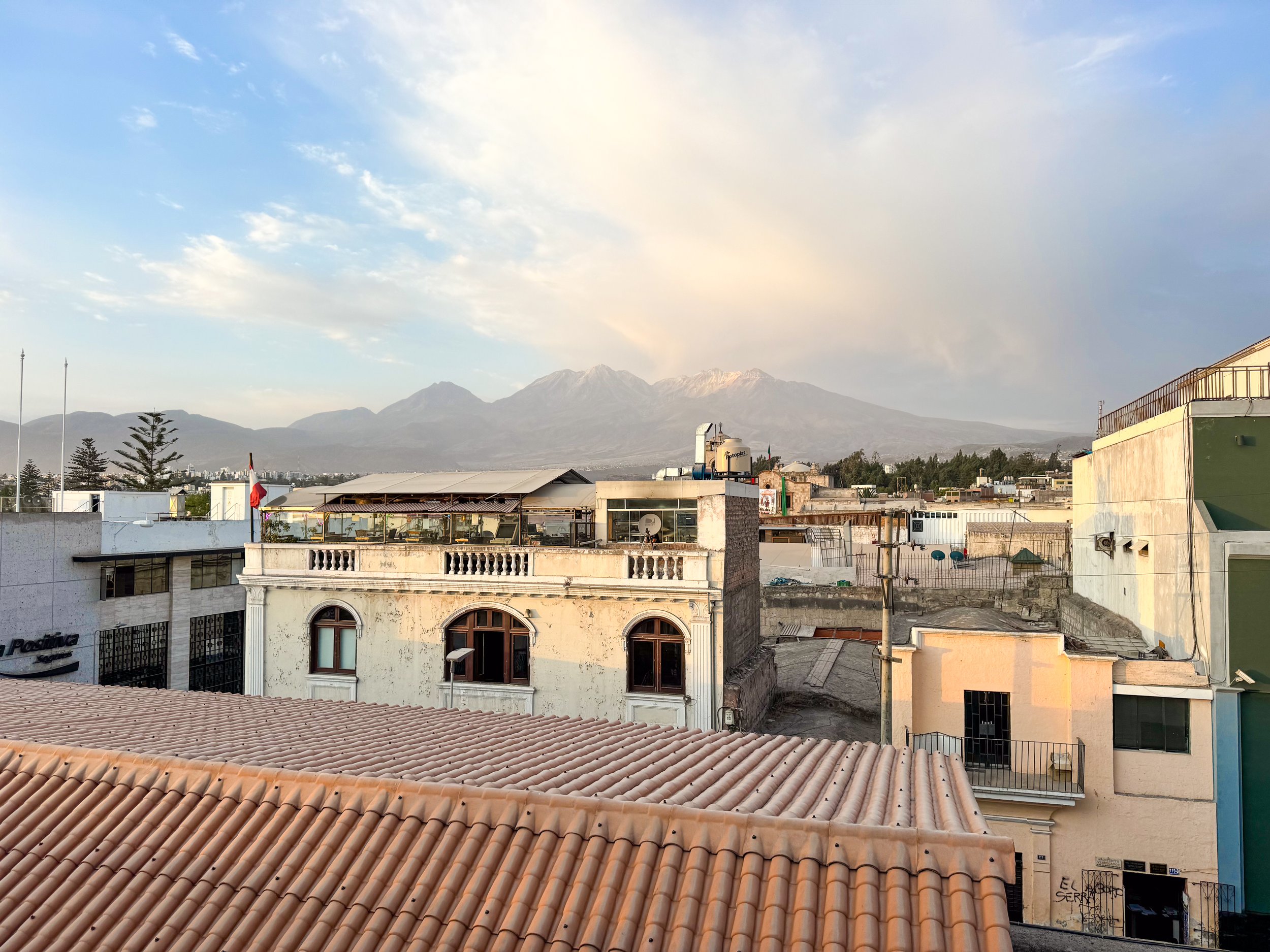
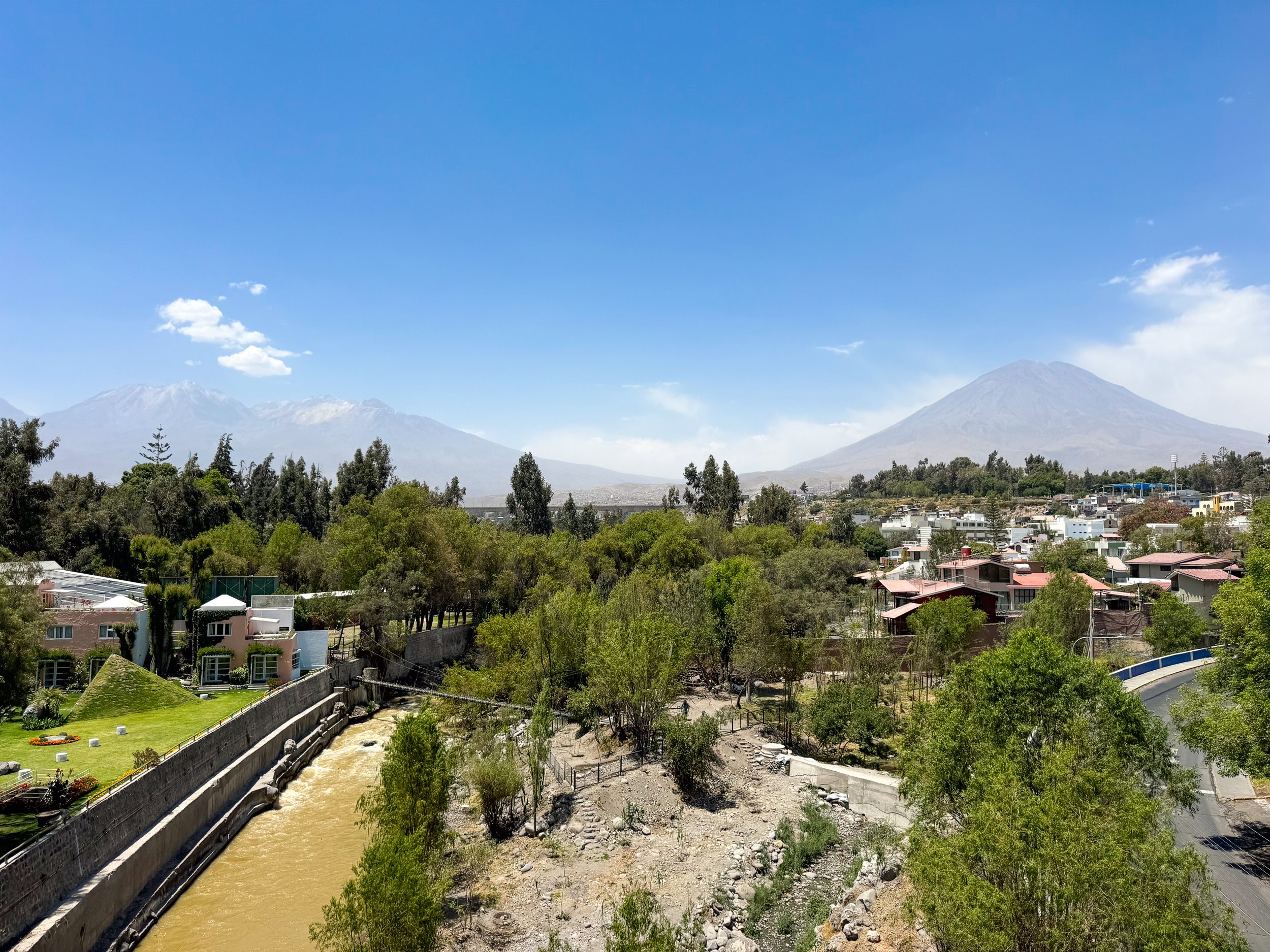
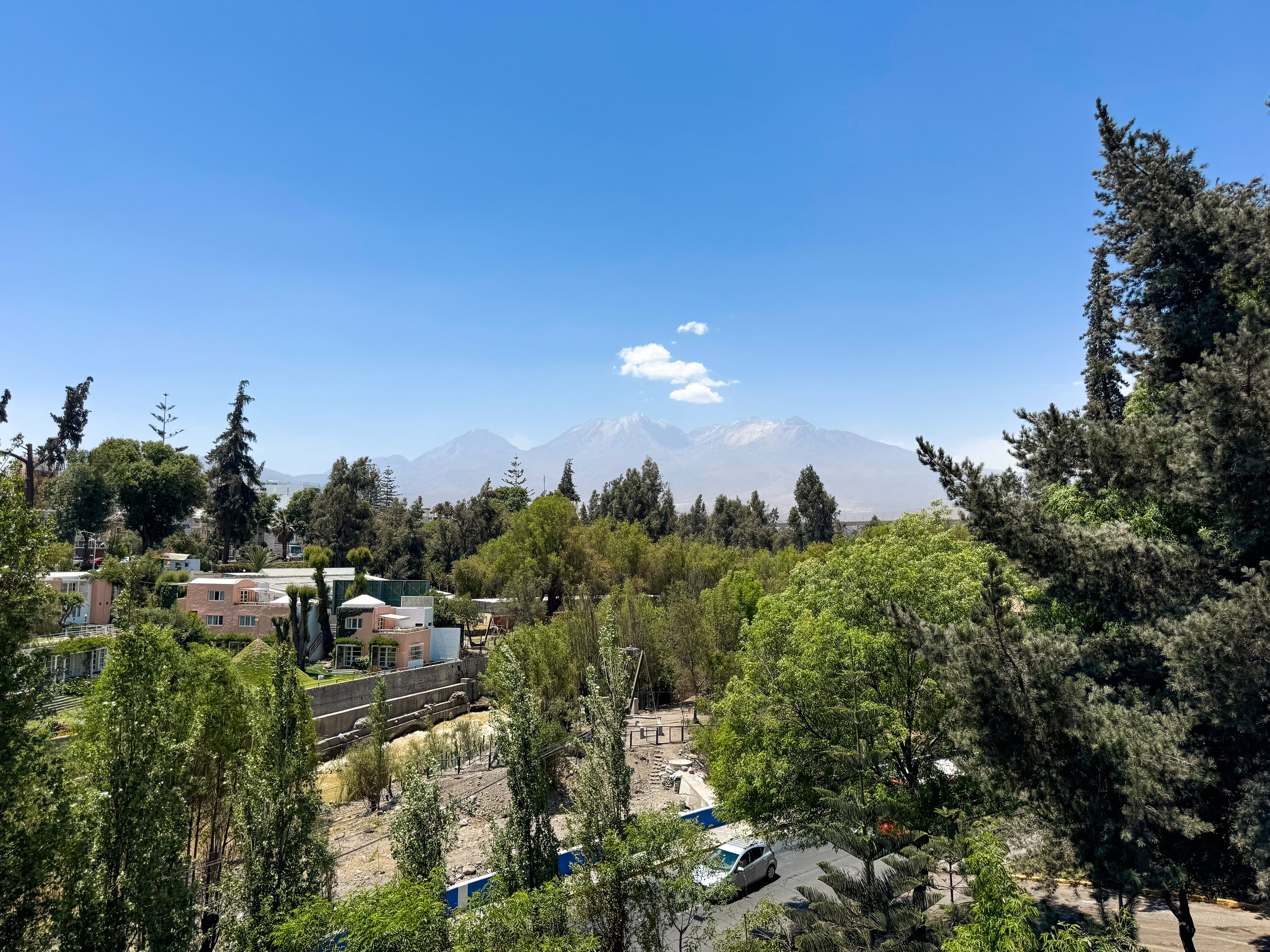
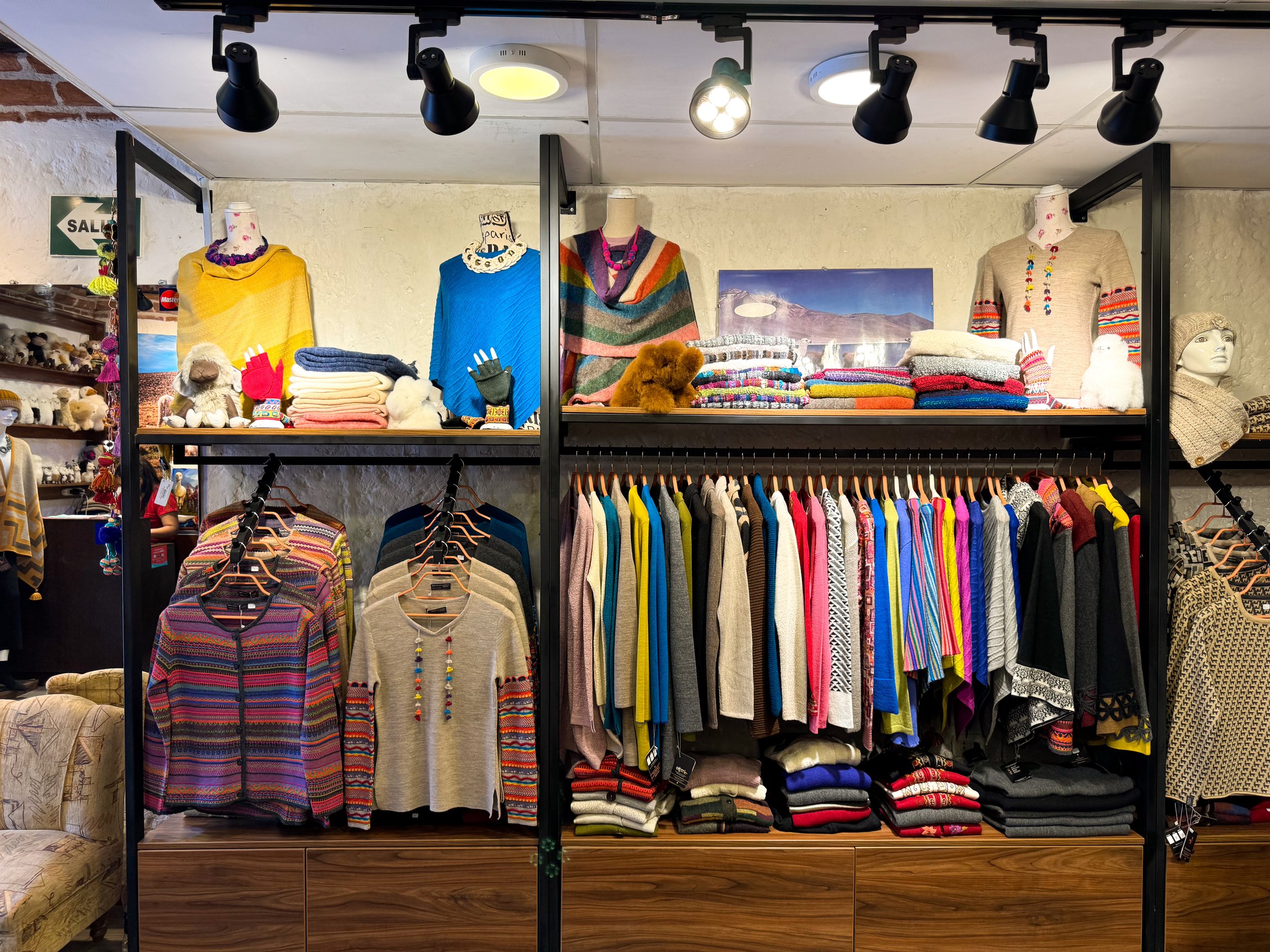
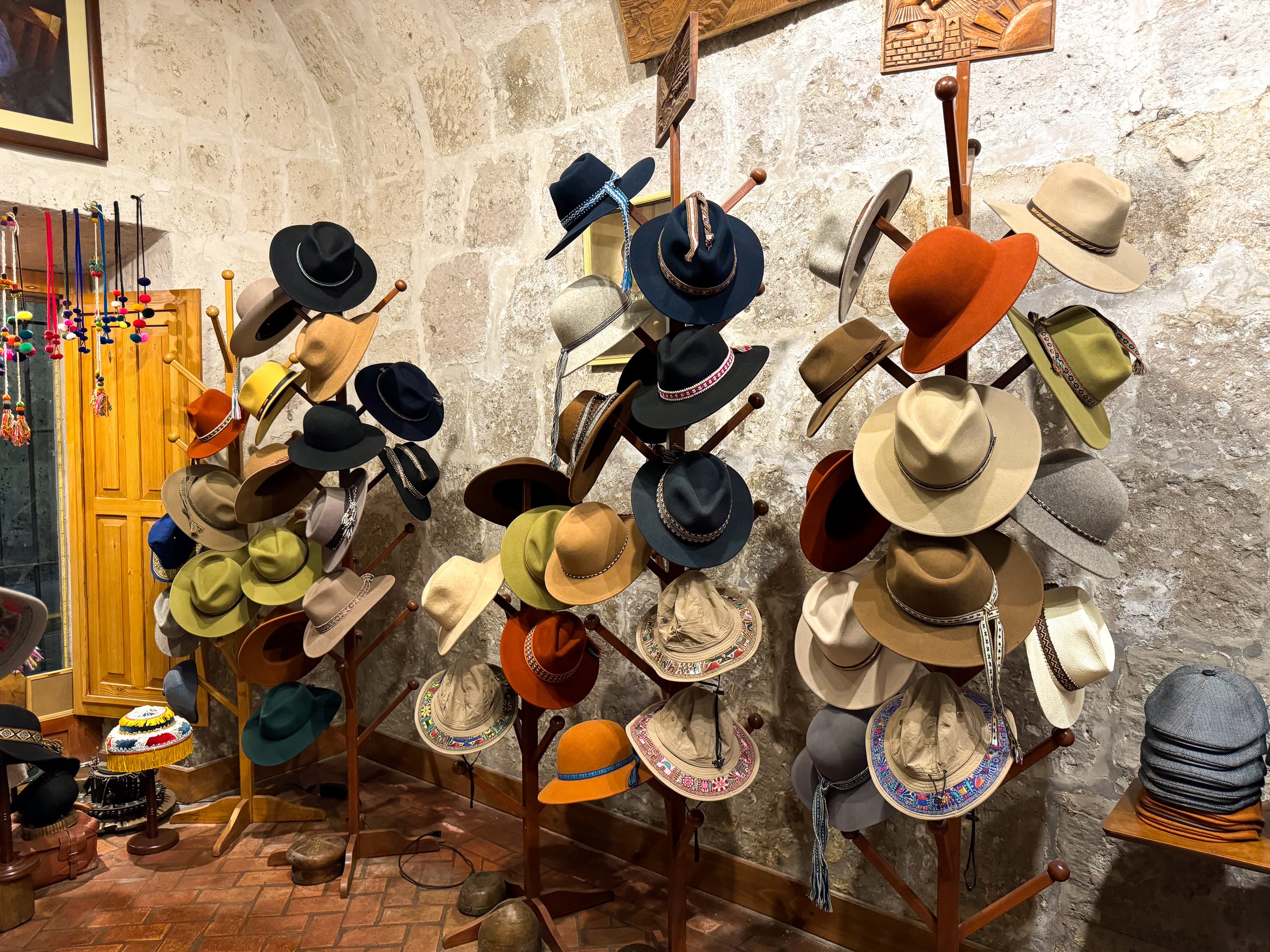
Things to Do
Pose with the Alpaca Ladies. A group of indigenous women dressed in traditional clothing walking baby alpacas. Pose with them and the alpaca for a small tip. When posing for photo, make sure to top each woman individually.
Puente Grau. Walk across the Puente Grau bridge with views of the Misti and Chachani volcanoes.
Eat & Drink at Roof Top Restaurant. Many restaurants have rooftop terraces and bars across Arequipa. They’re popular for leisurely breakfasts, enjoying views of the city, volcanos and sunsets.
Alpaca Shopping. Go shopping for alpaca, llama or vicuna fur clothes, accessories or home goods.
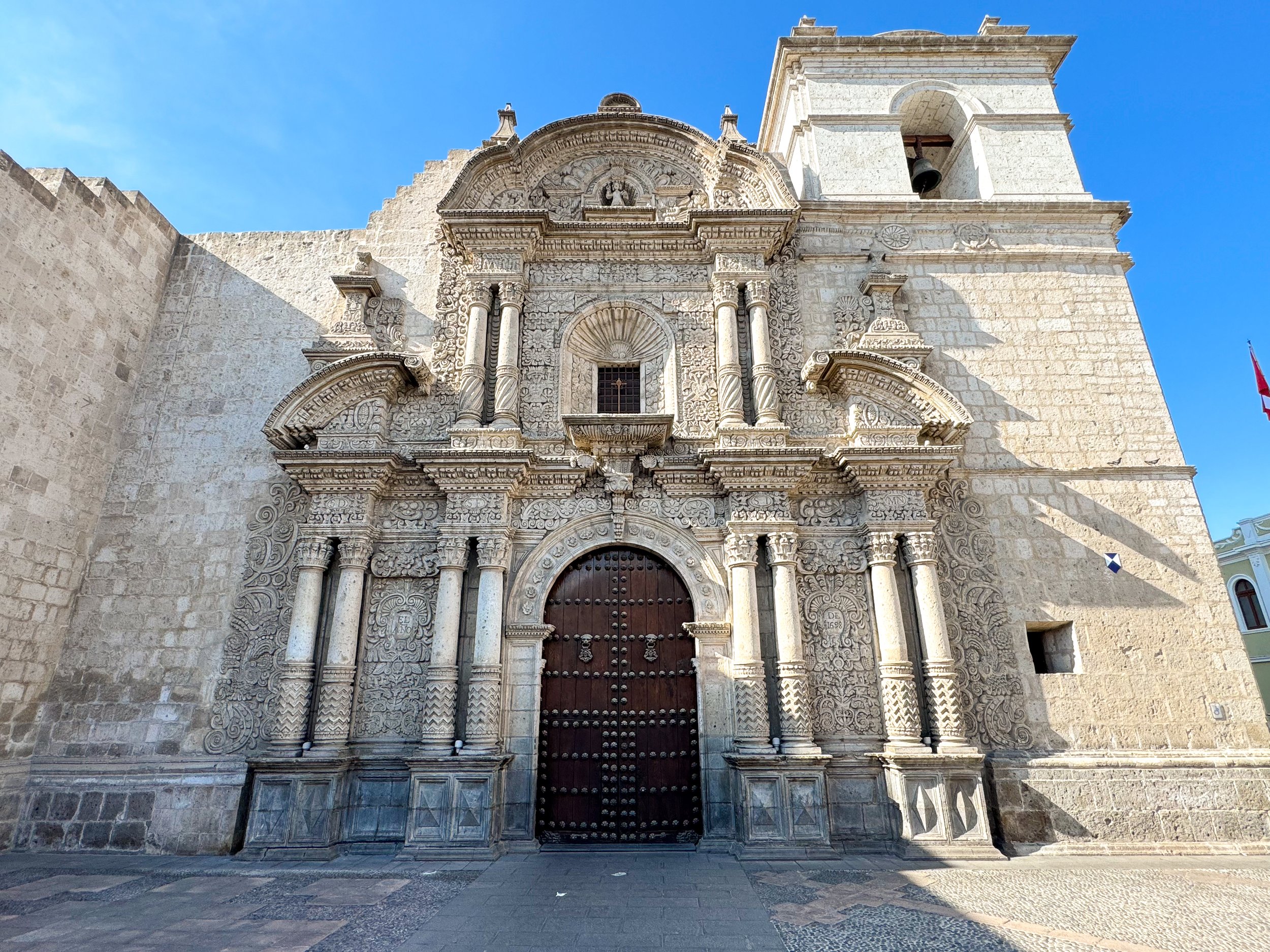
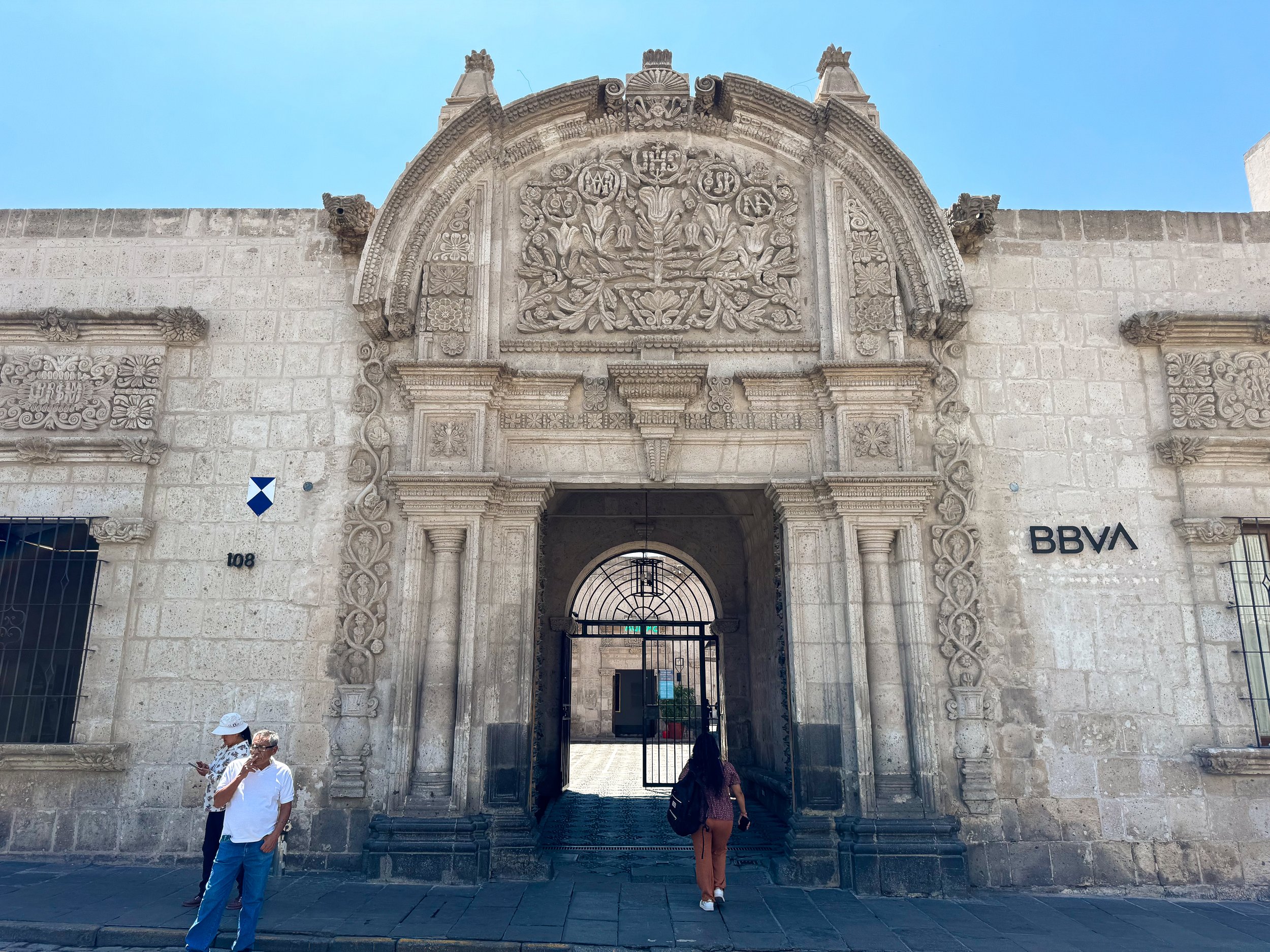

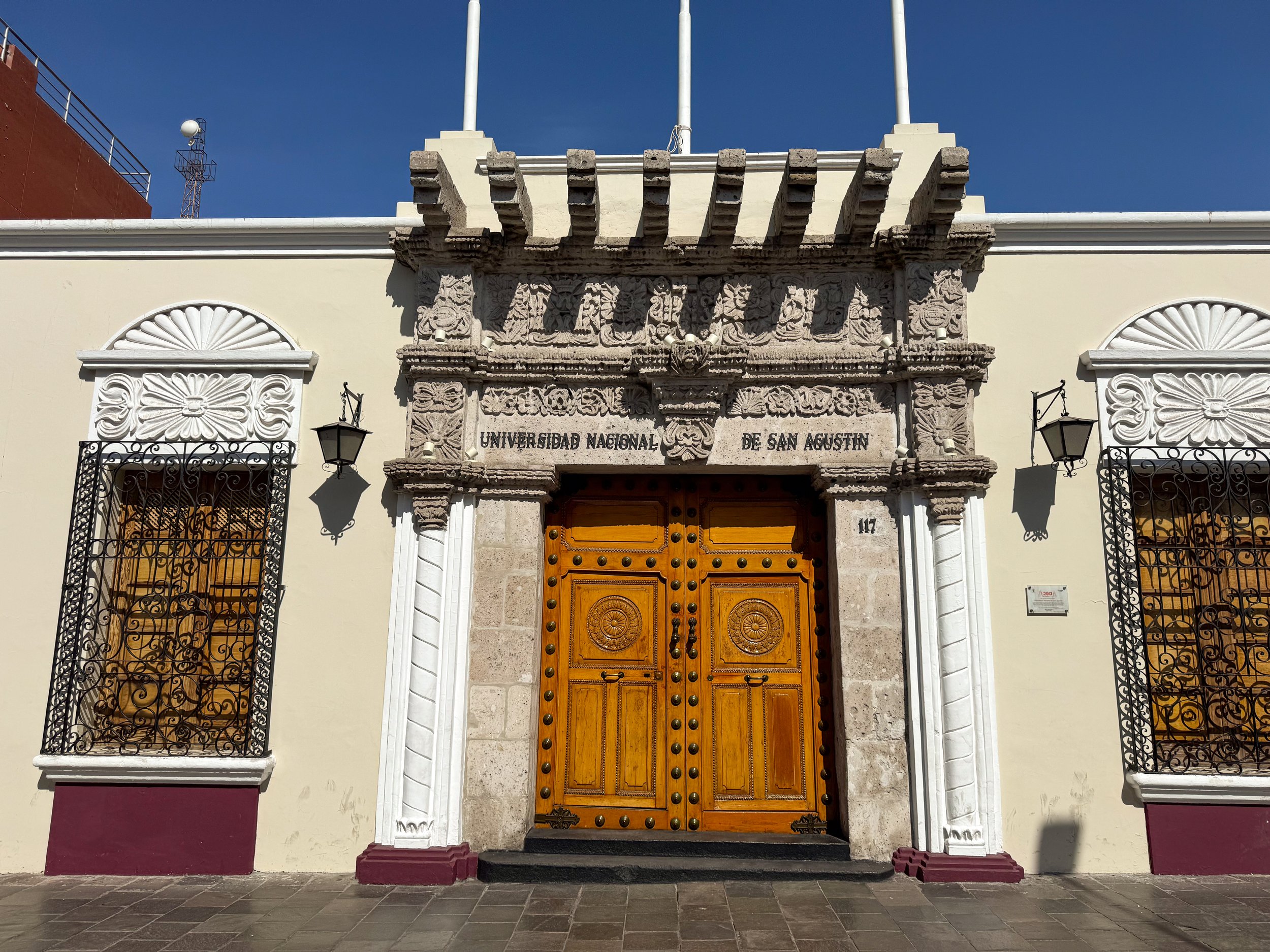
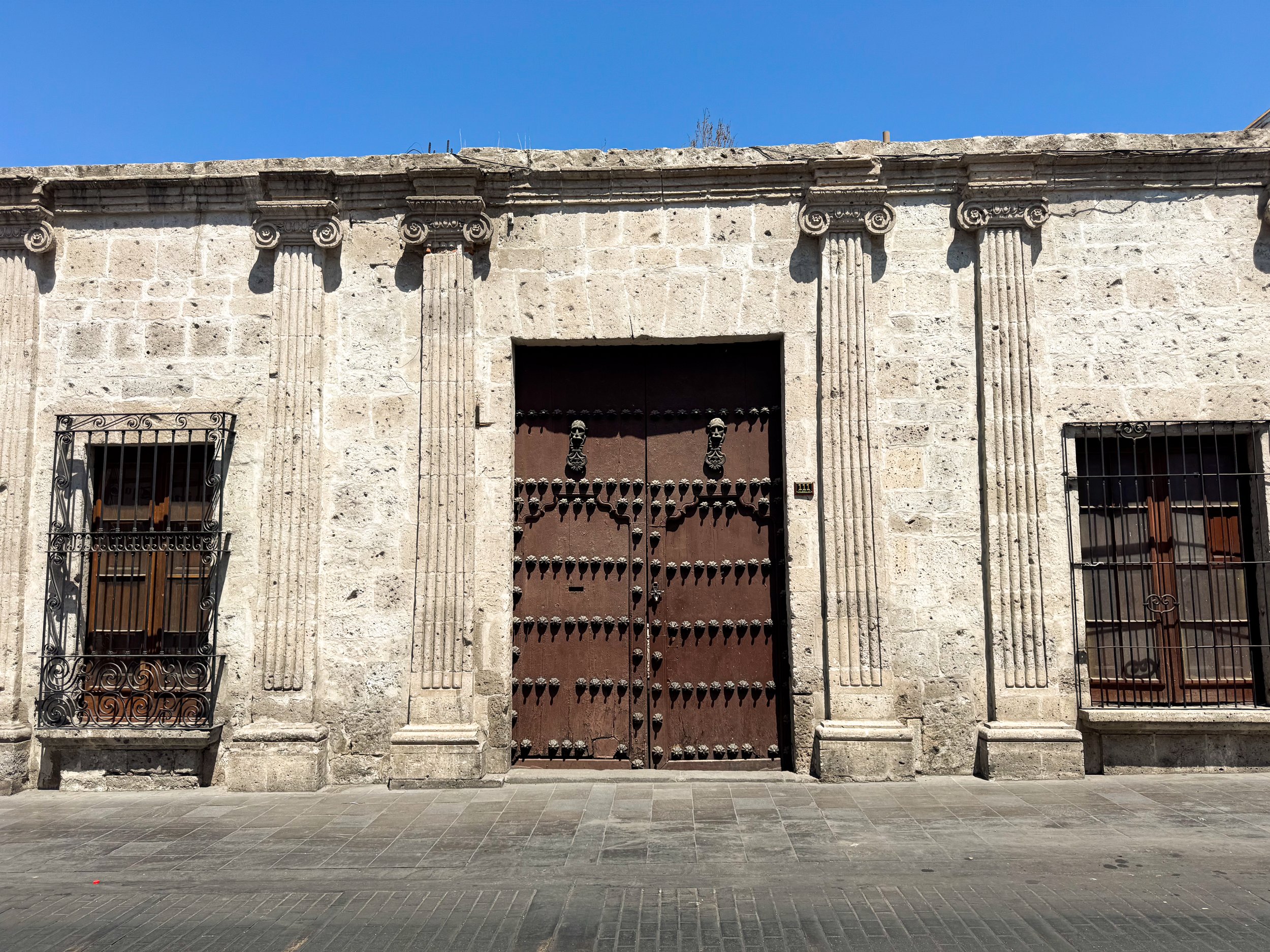
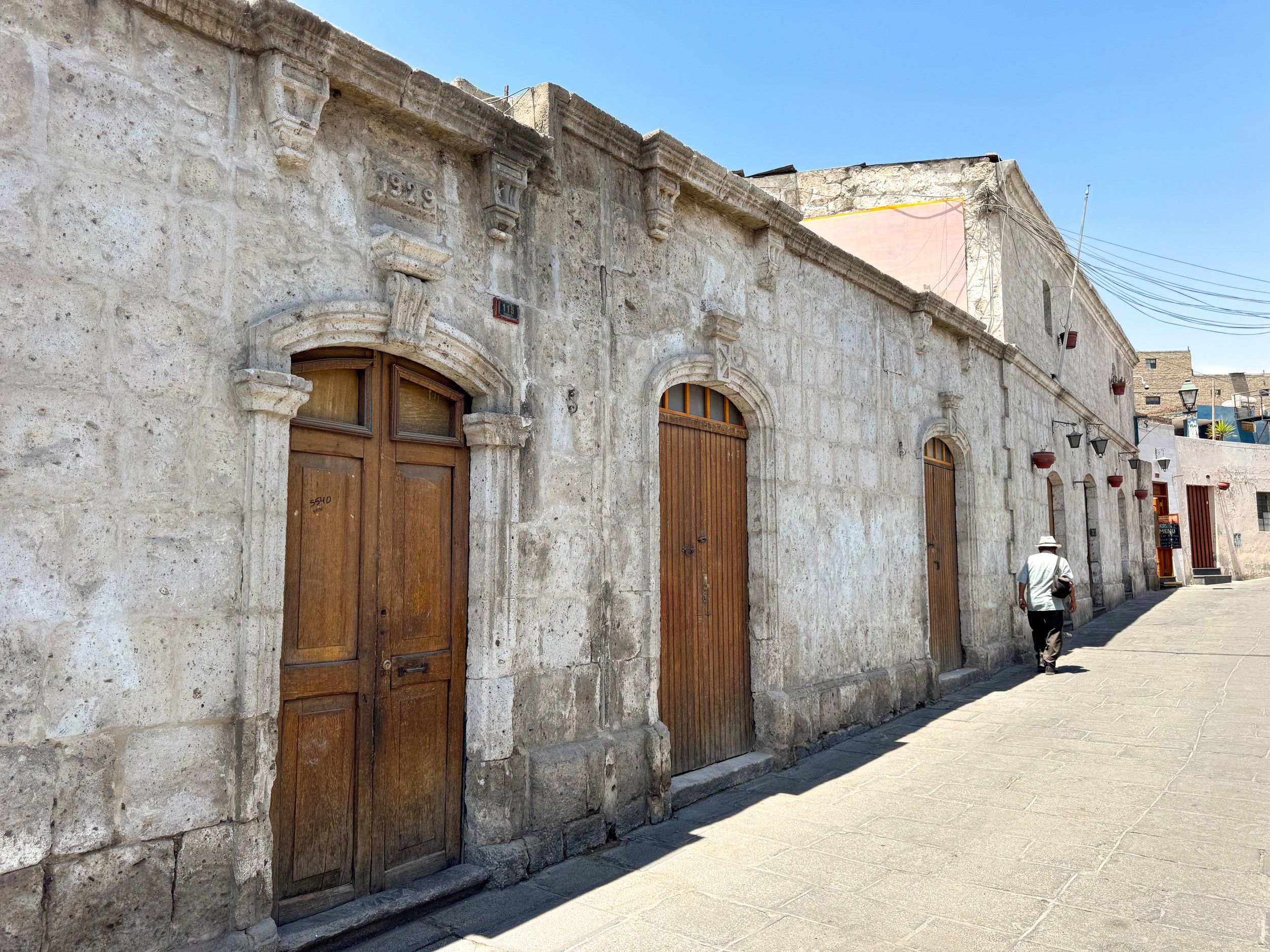
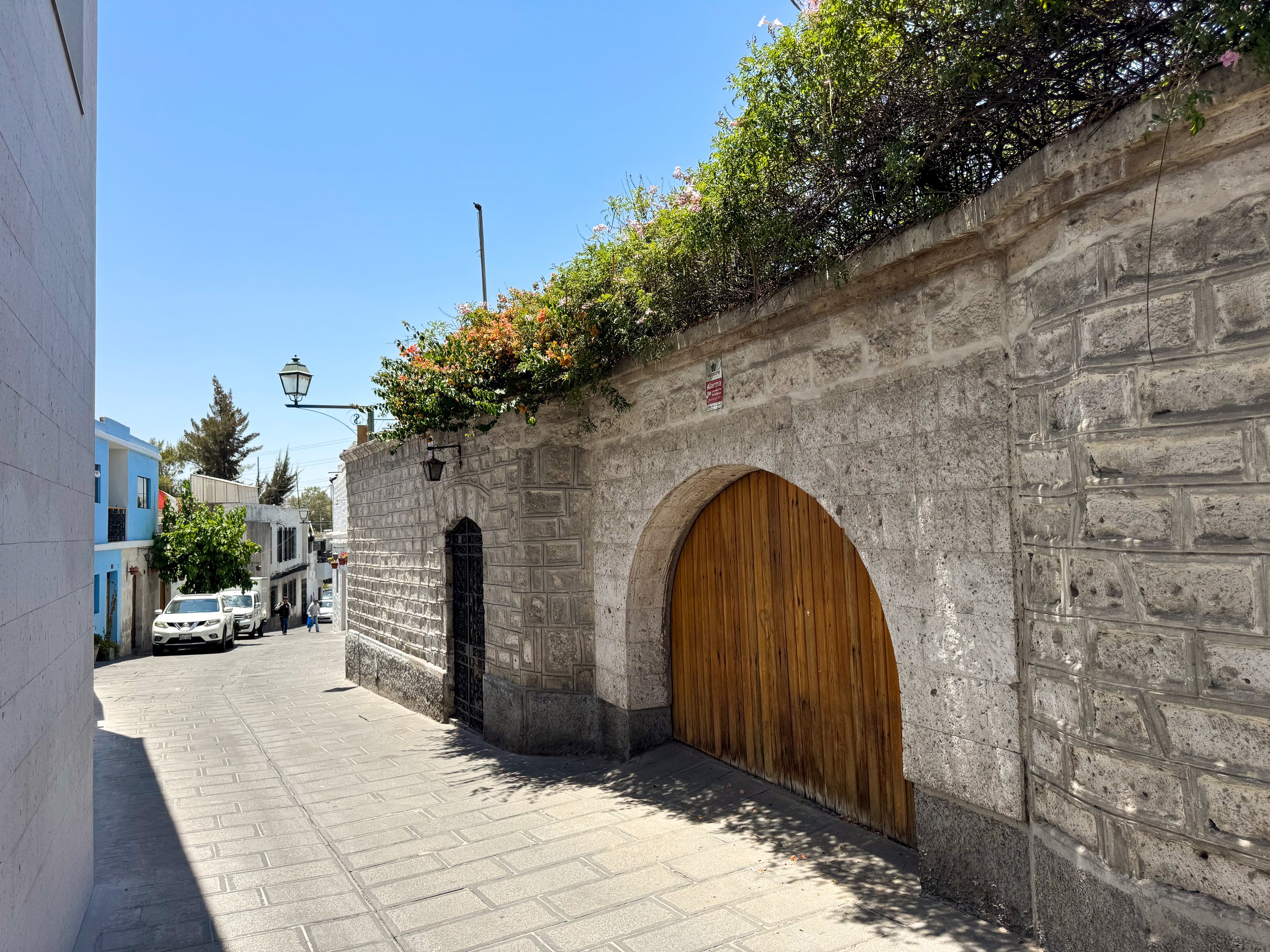
Admire The White City. Arequipa is called “The White City” for its buildings made from white volcanic stone and their ornate baroque style facades. We walked around the city admiring the architecture and touring landmark buildings. There are also walking tours in the Plaza de Armas based on tips.
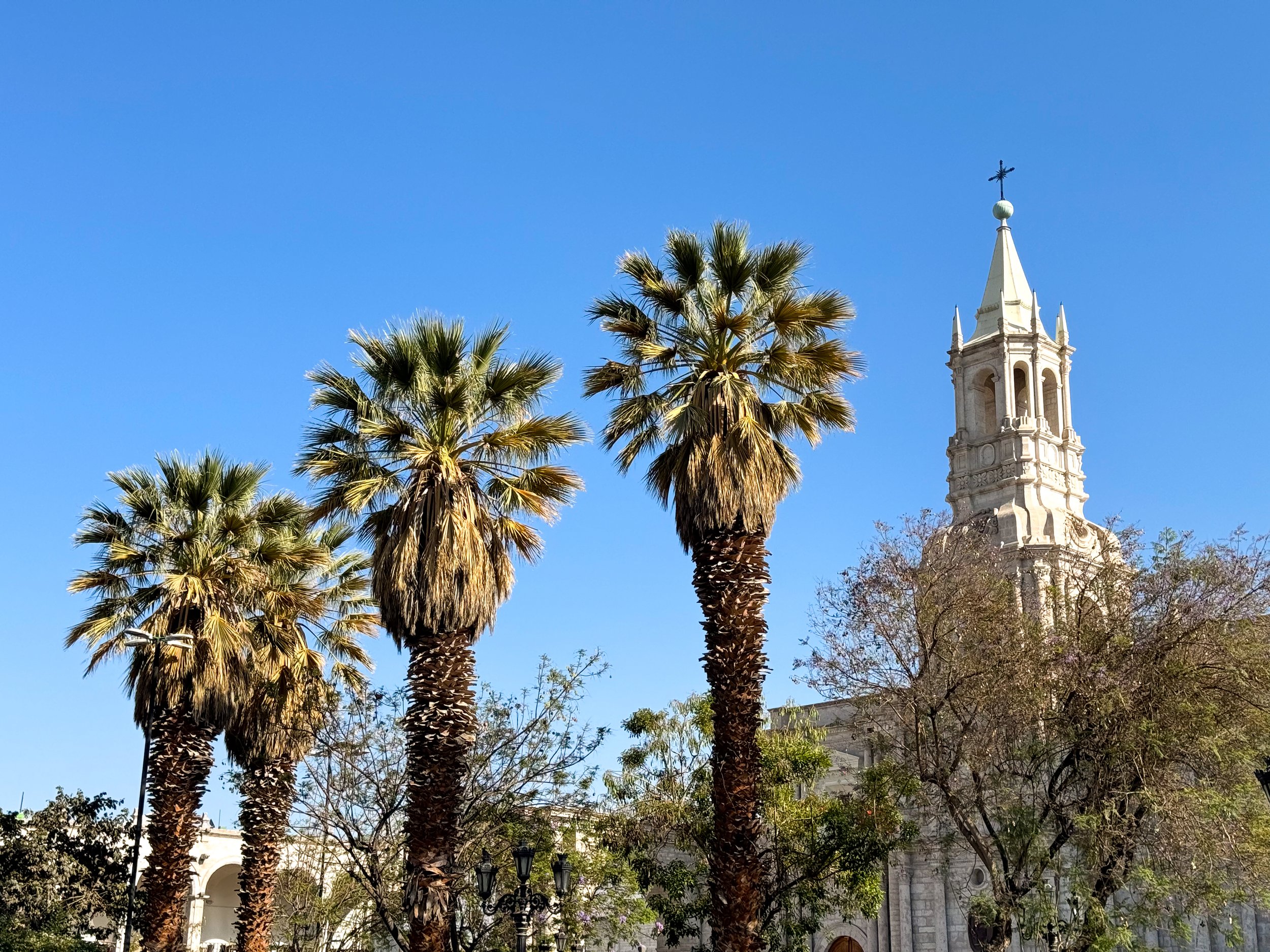
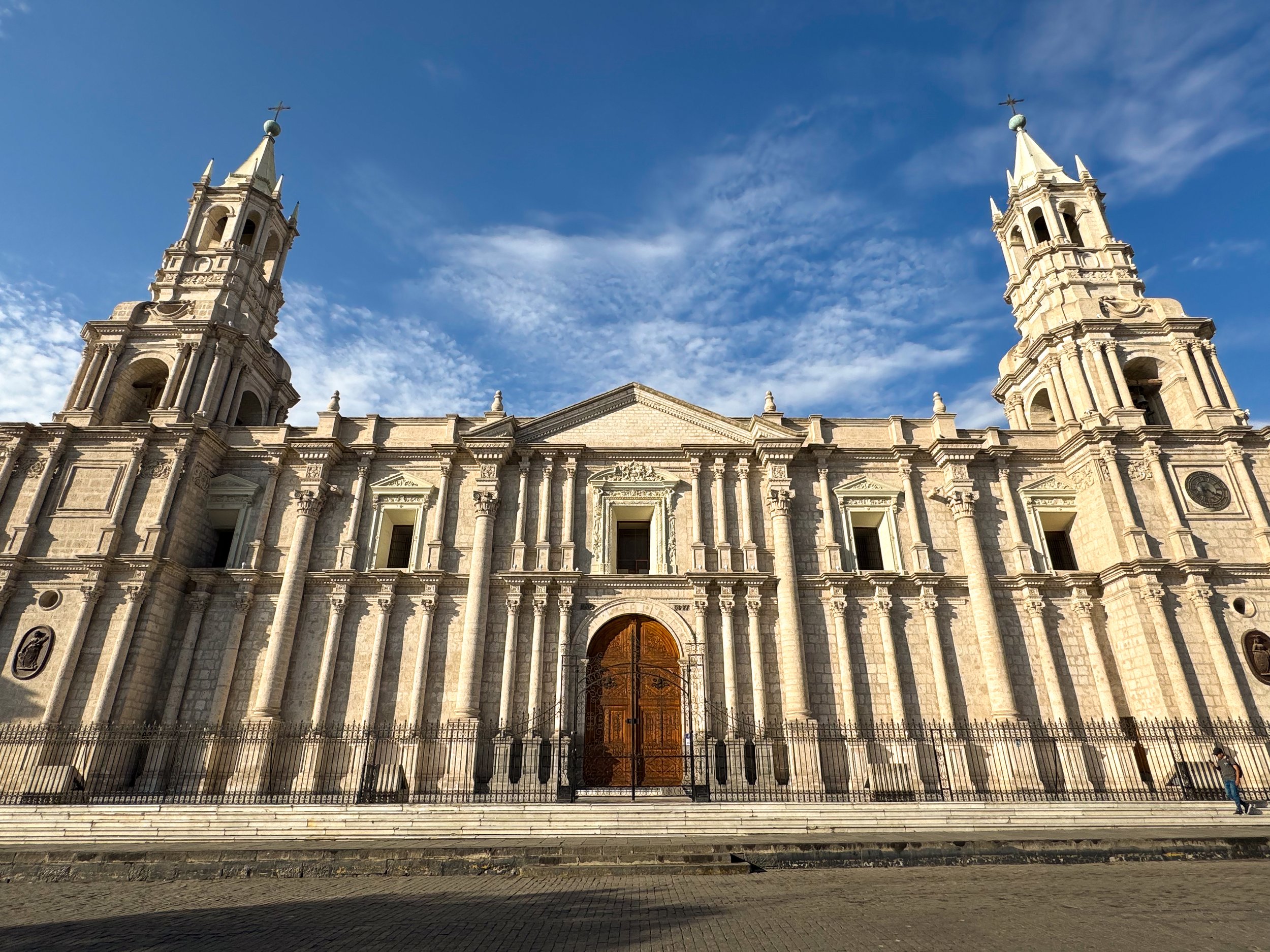
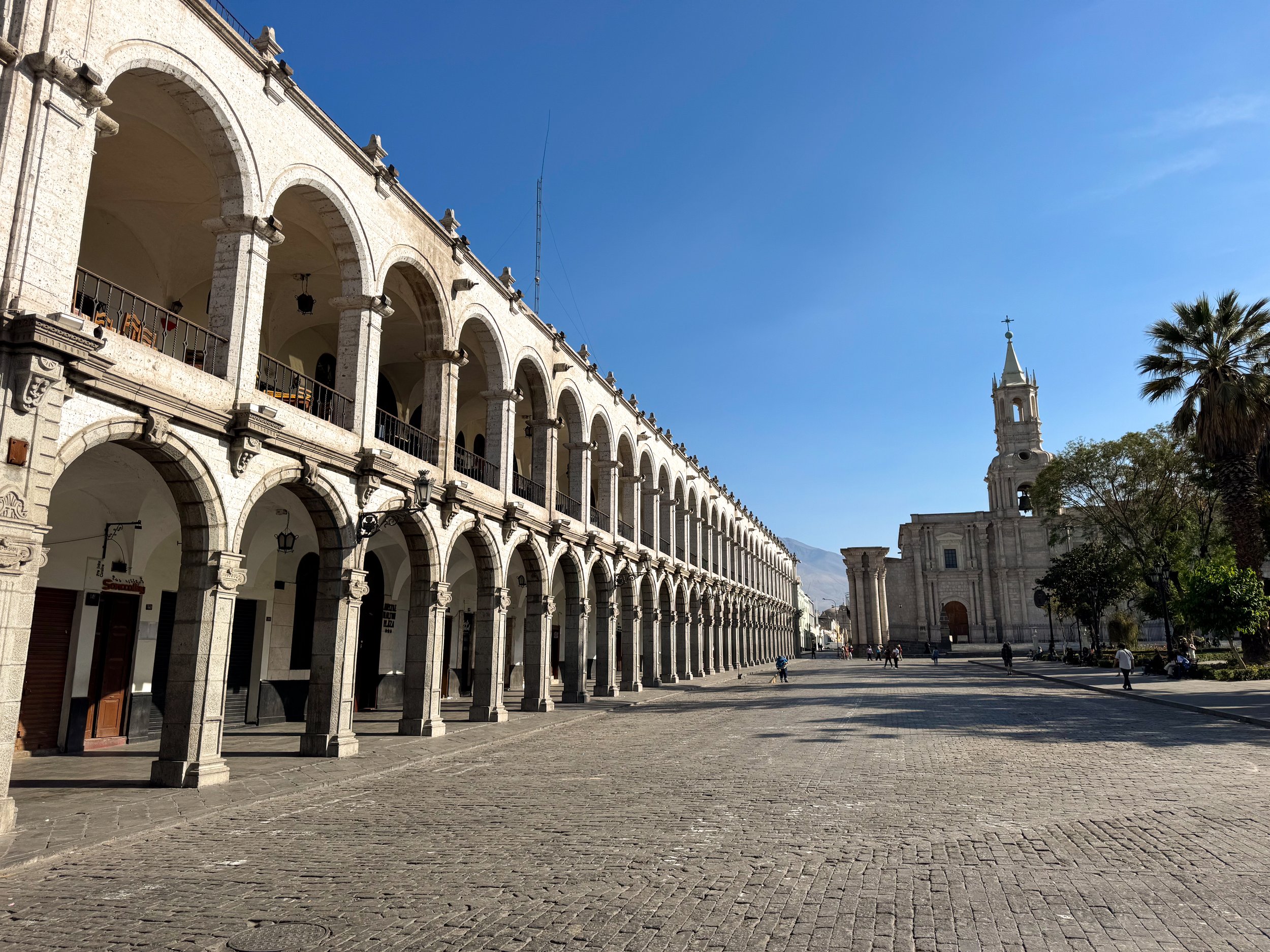
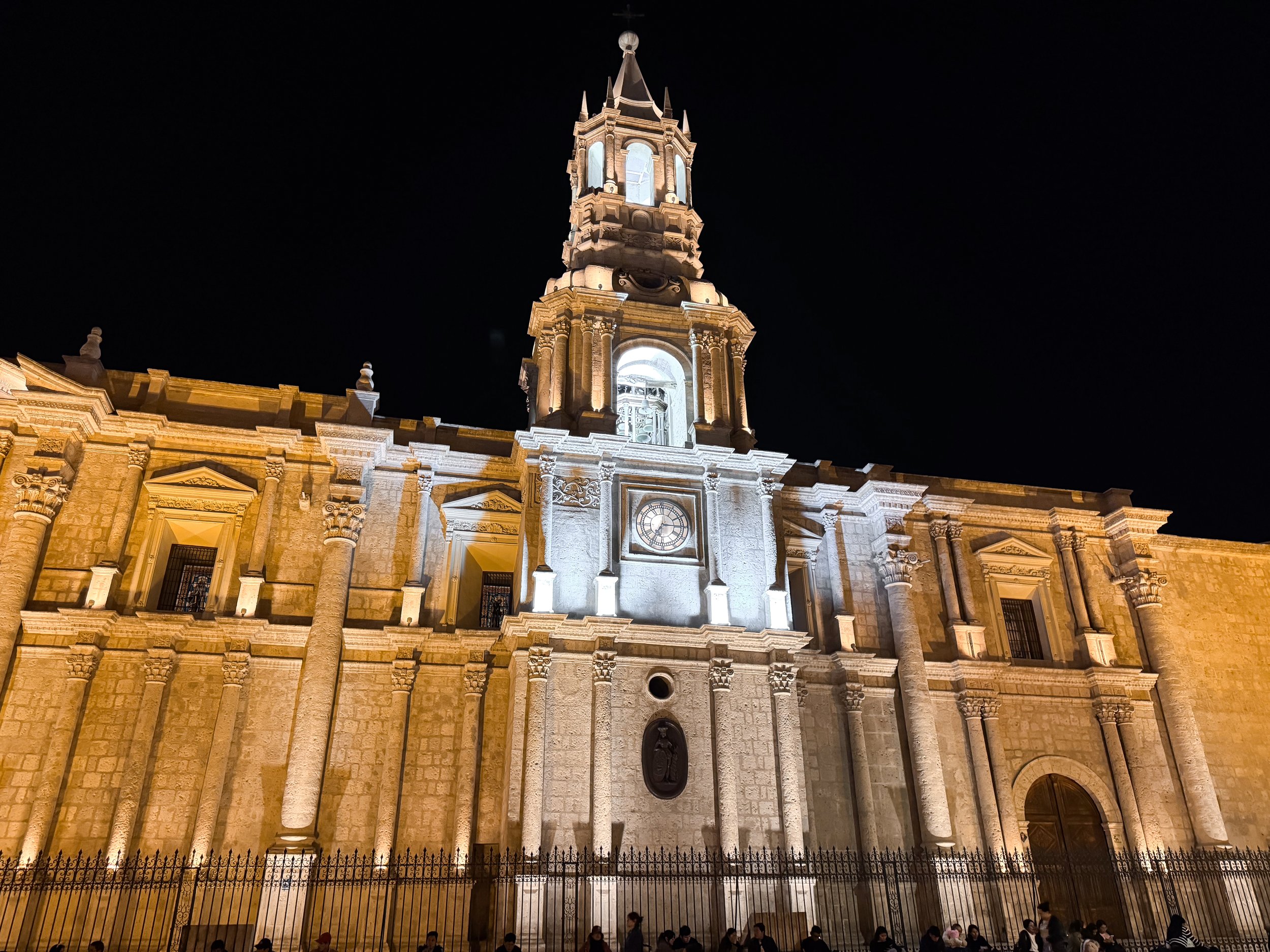
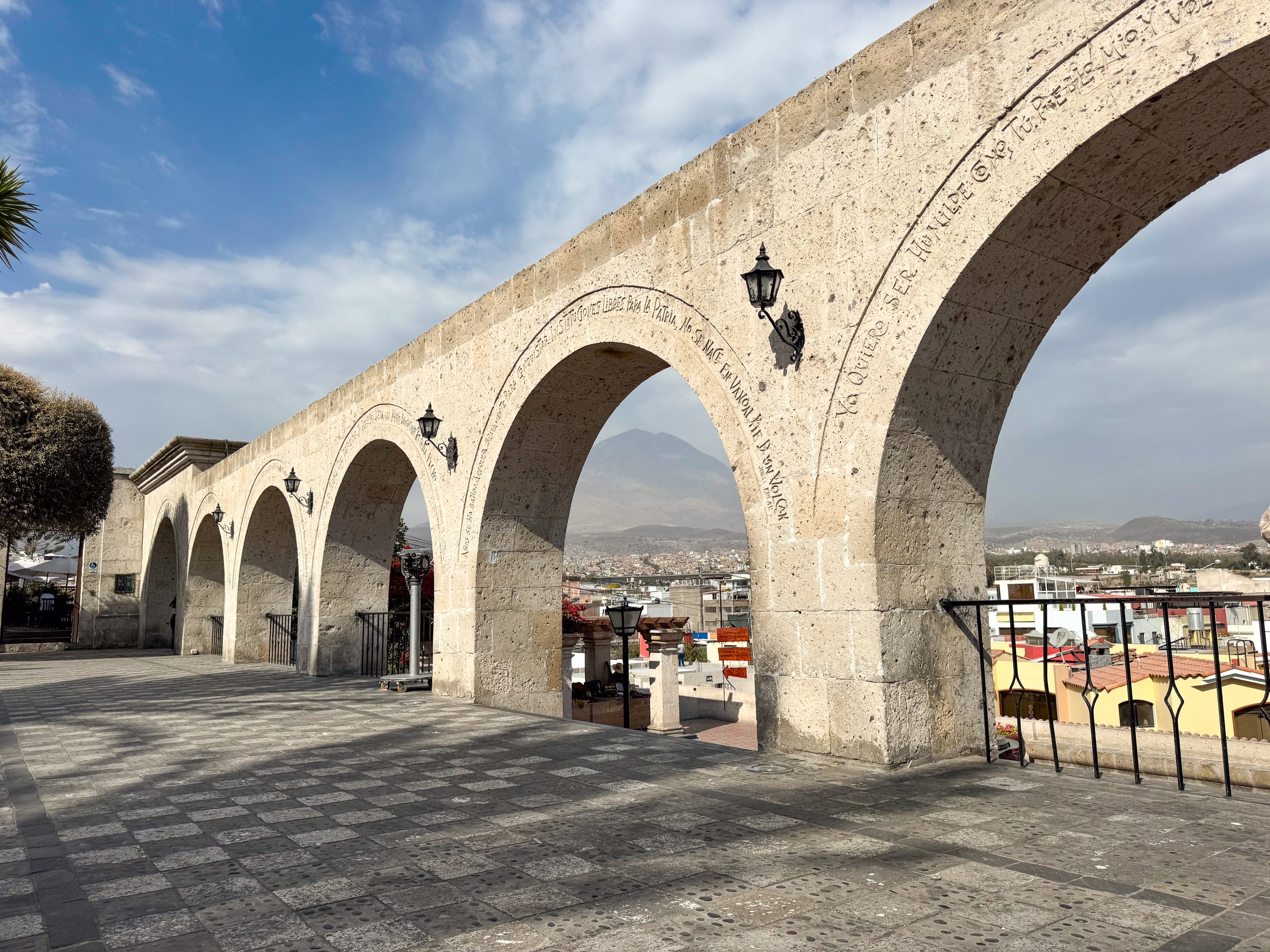
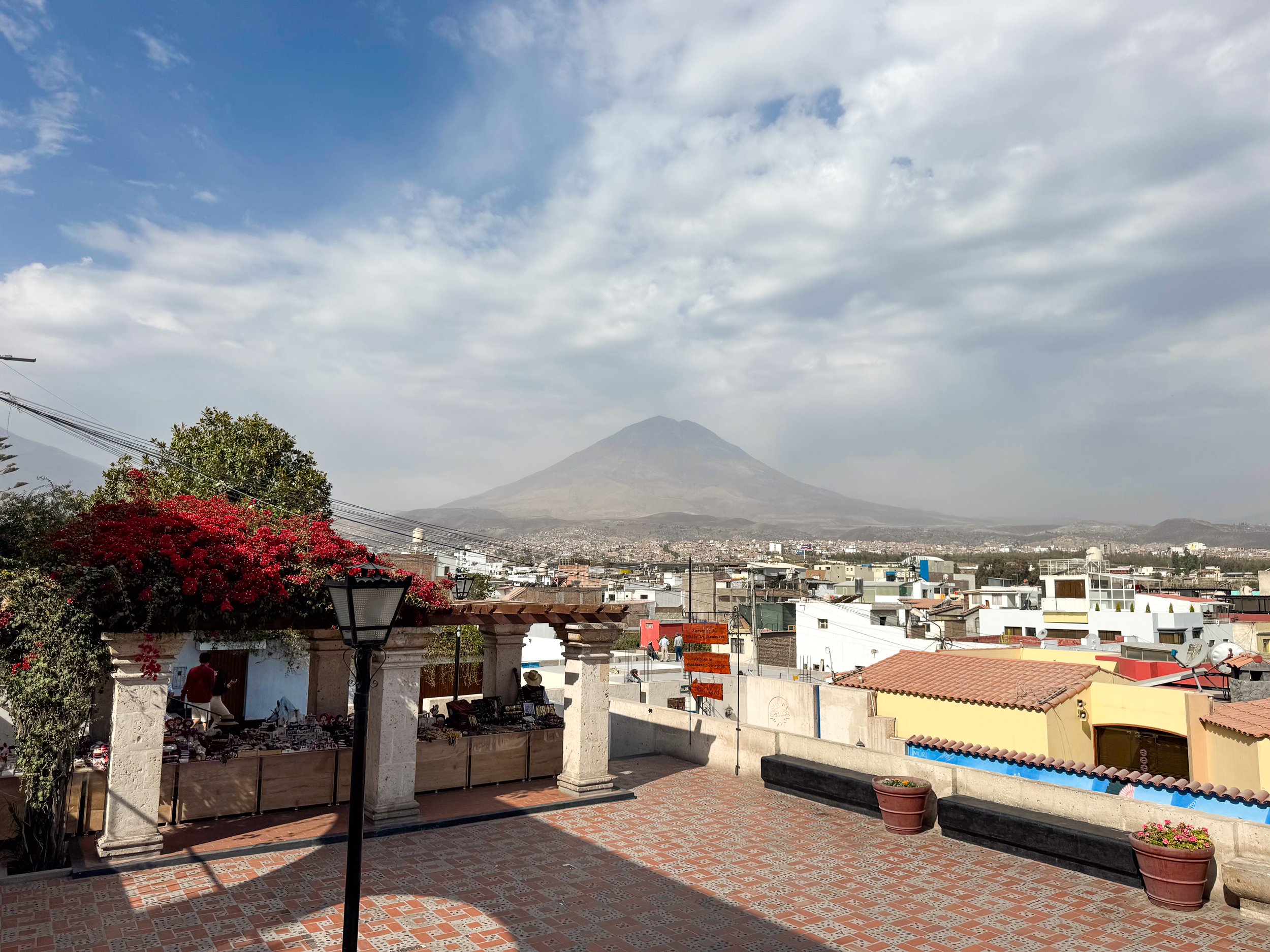
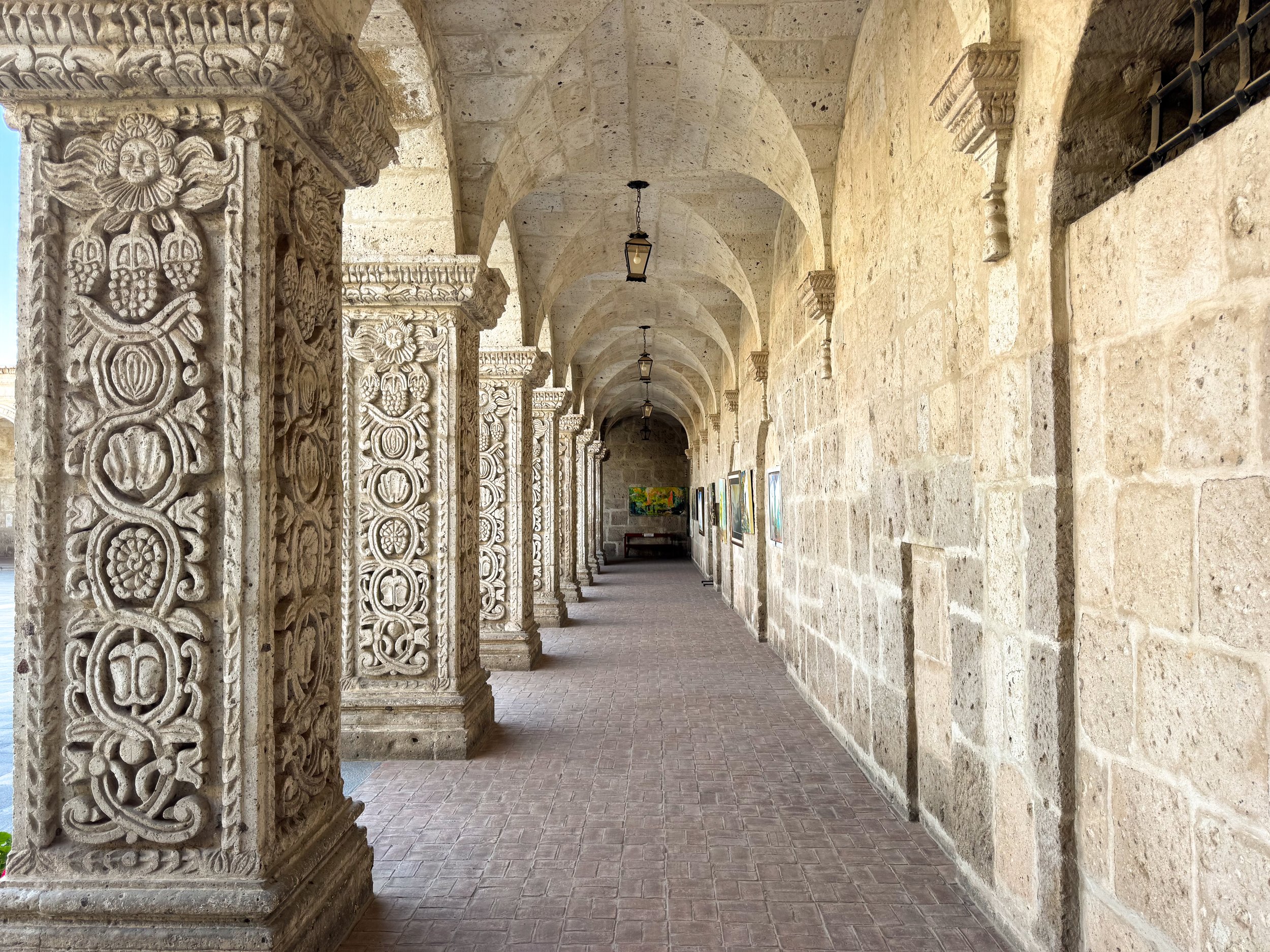
Sights
Plaza de Armas. A palm lined plaza at the heart of Arequipa’s historic neighborhood surrounded by white arched buildings and centered on the Basilica of Arequipa. It’s a culture center where locals come to relax and the city hosts events like live music and artisan markets.
Basilica of Arequipa. A grand neo-gothic and renaissance style cathedral with two bell towers and ornate masonry built from white volcanic stone.
Cloisters of The Company. Two plazas with ornate white stone cloisters in the historic center of Arequipa home to cafes, bars and clothing stores selling alpaca and vicuña products.
Mirador Yanahuara. A palm lined plaza with an arched wall and lookout over the historic center of Arequipa and the Misti Volcano.
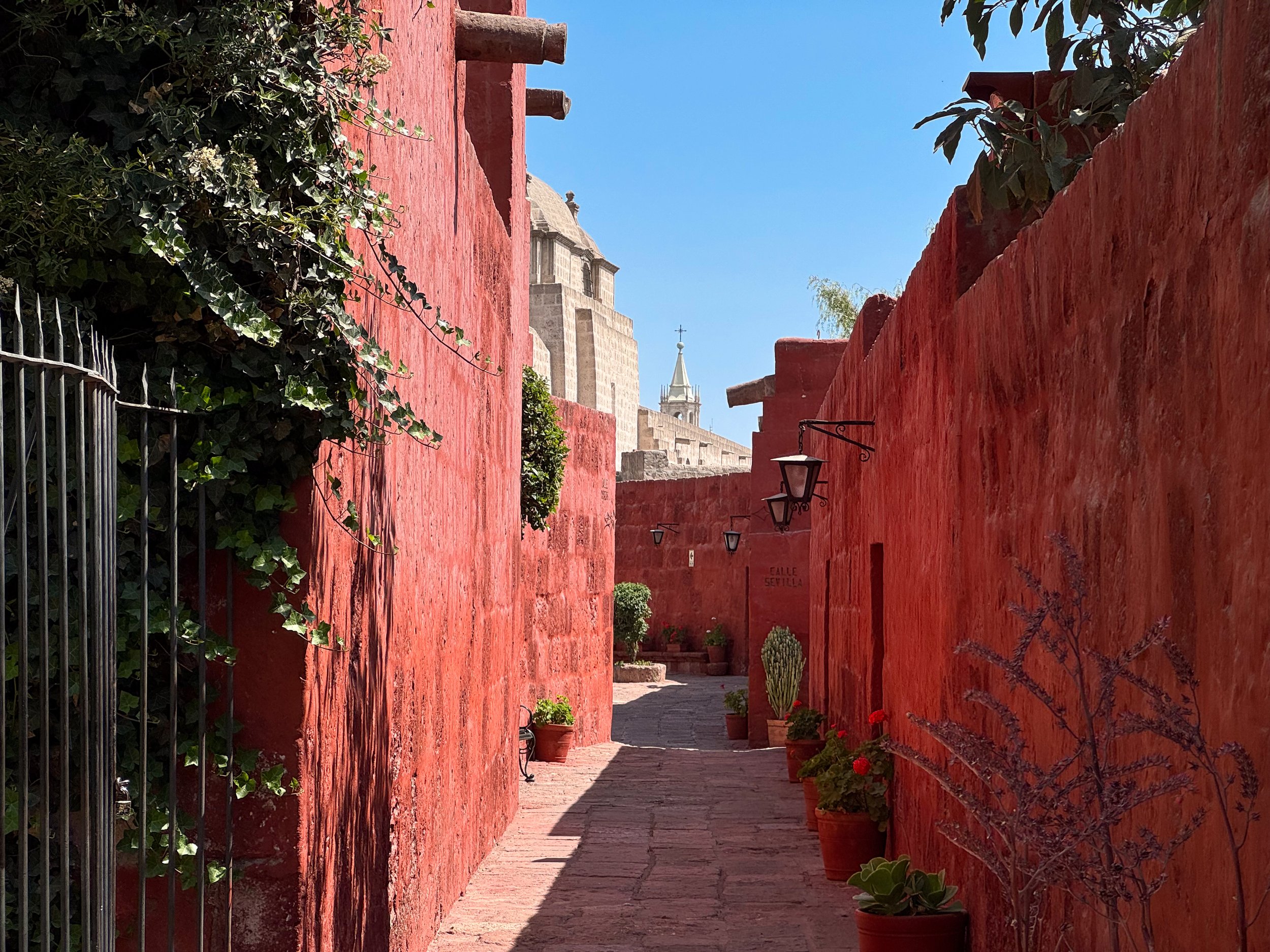
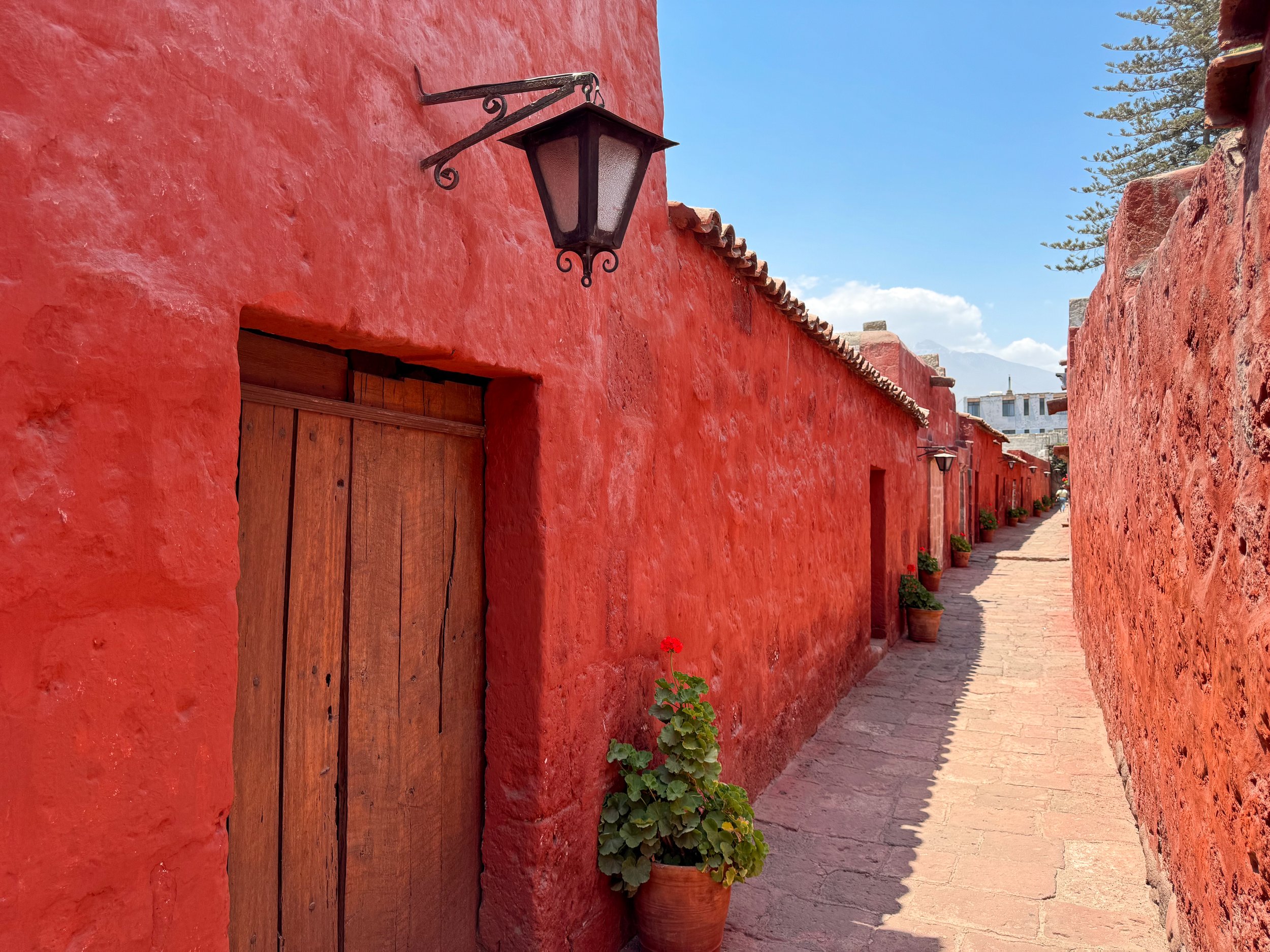
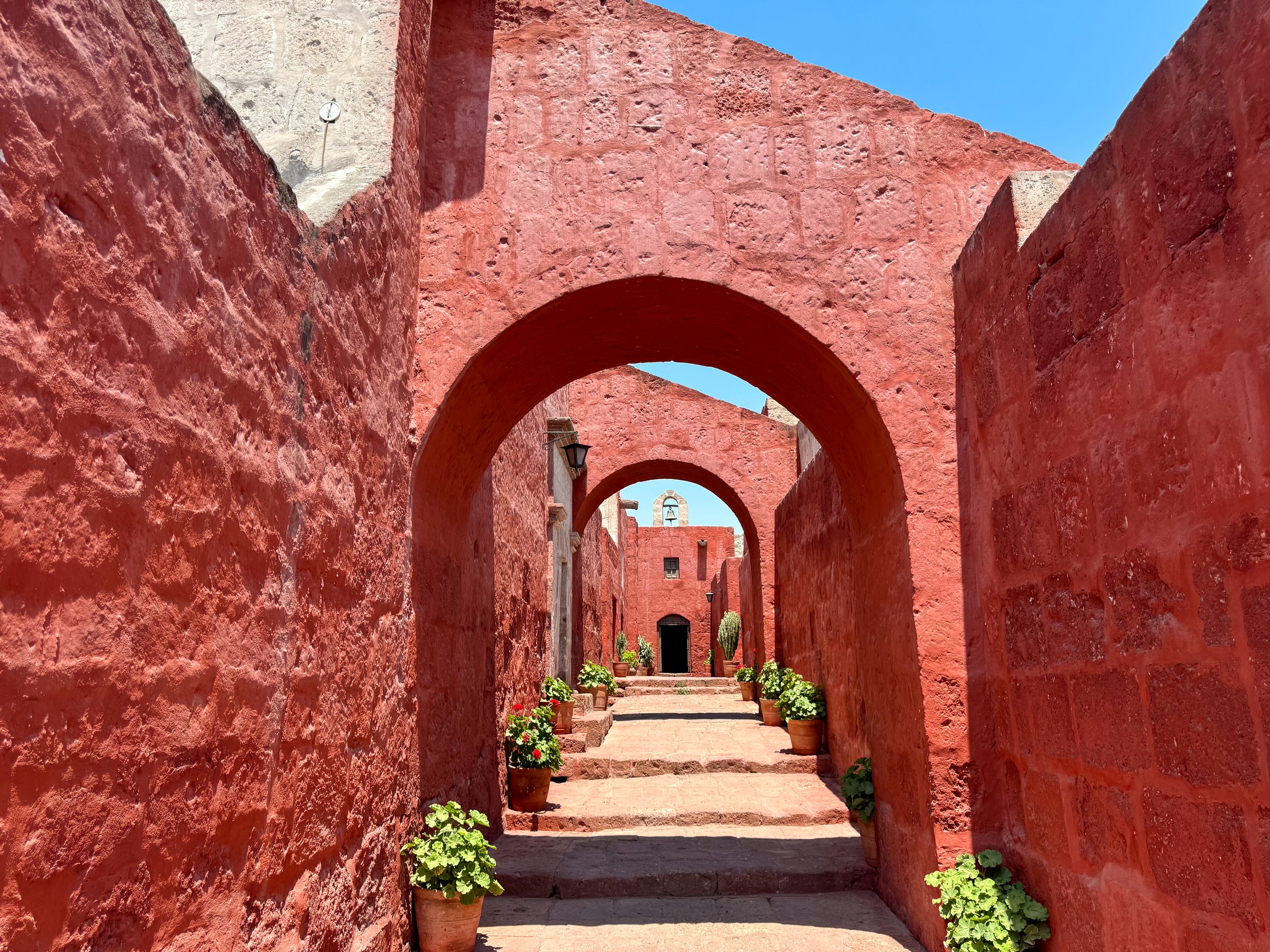
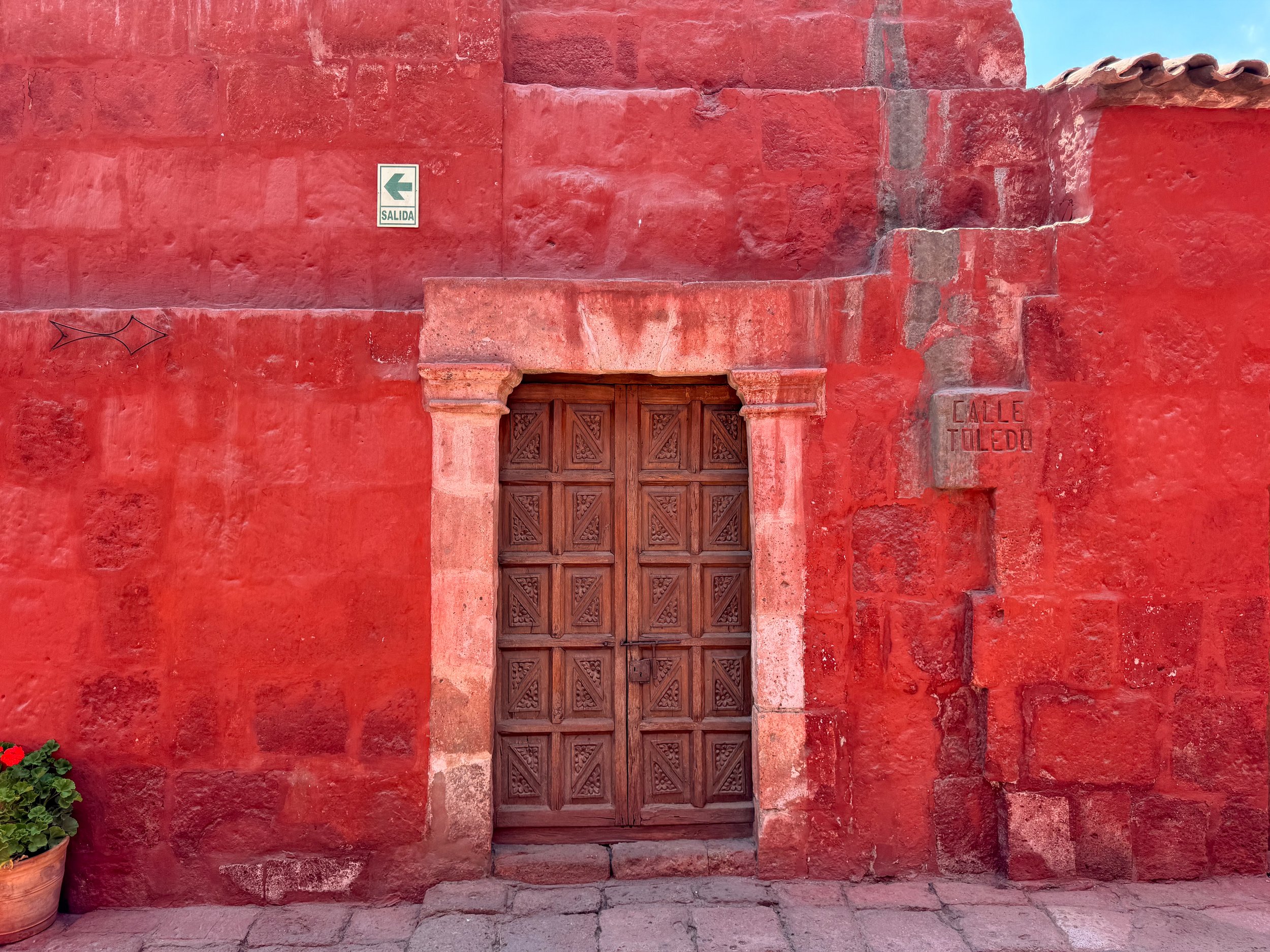
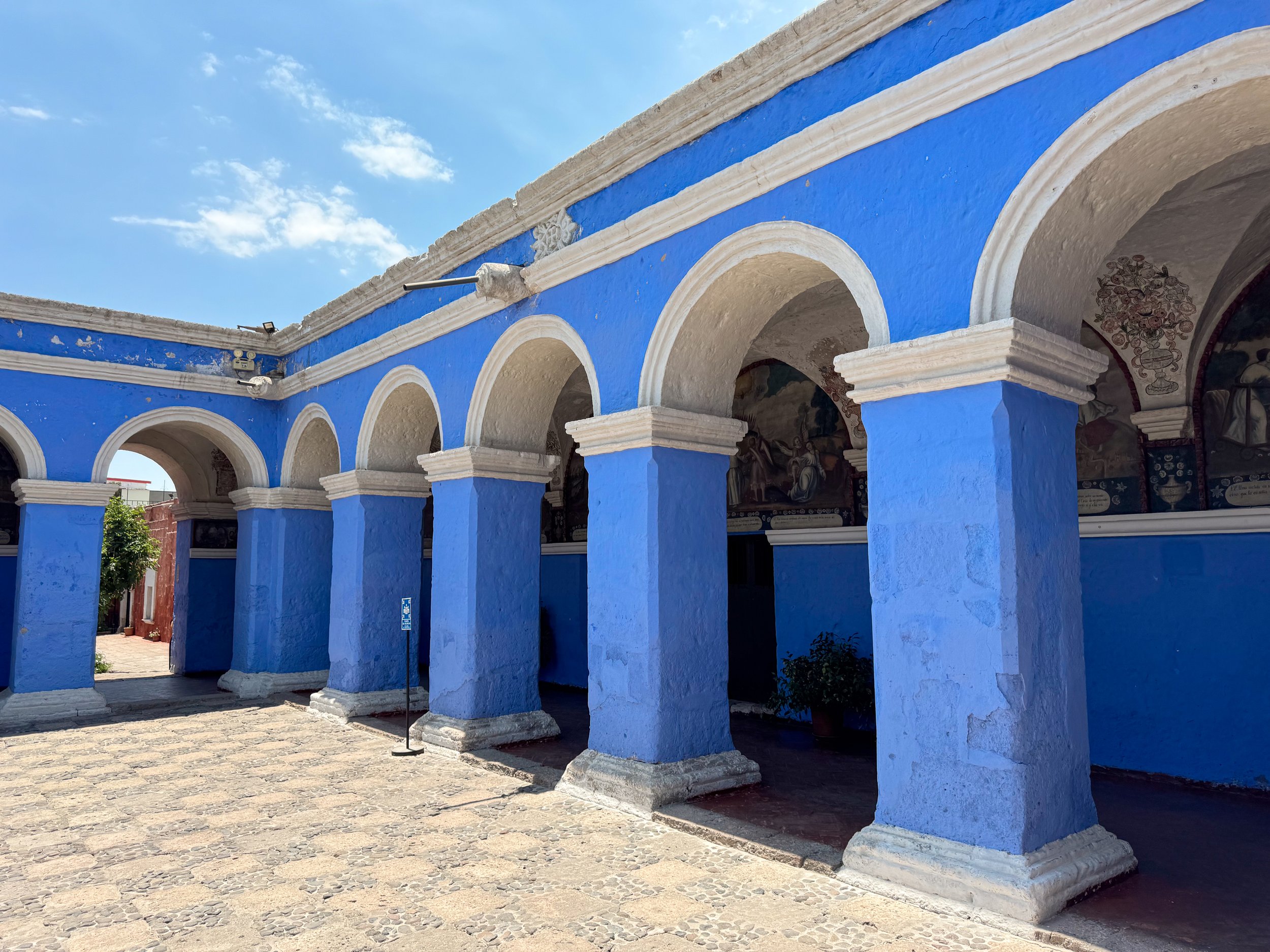
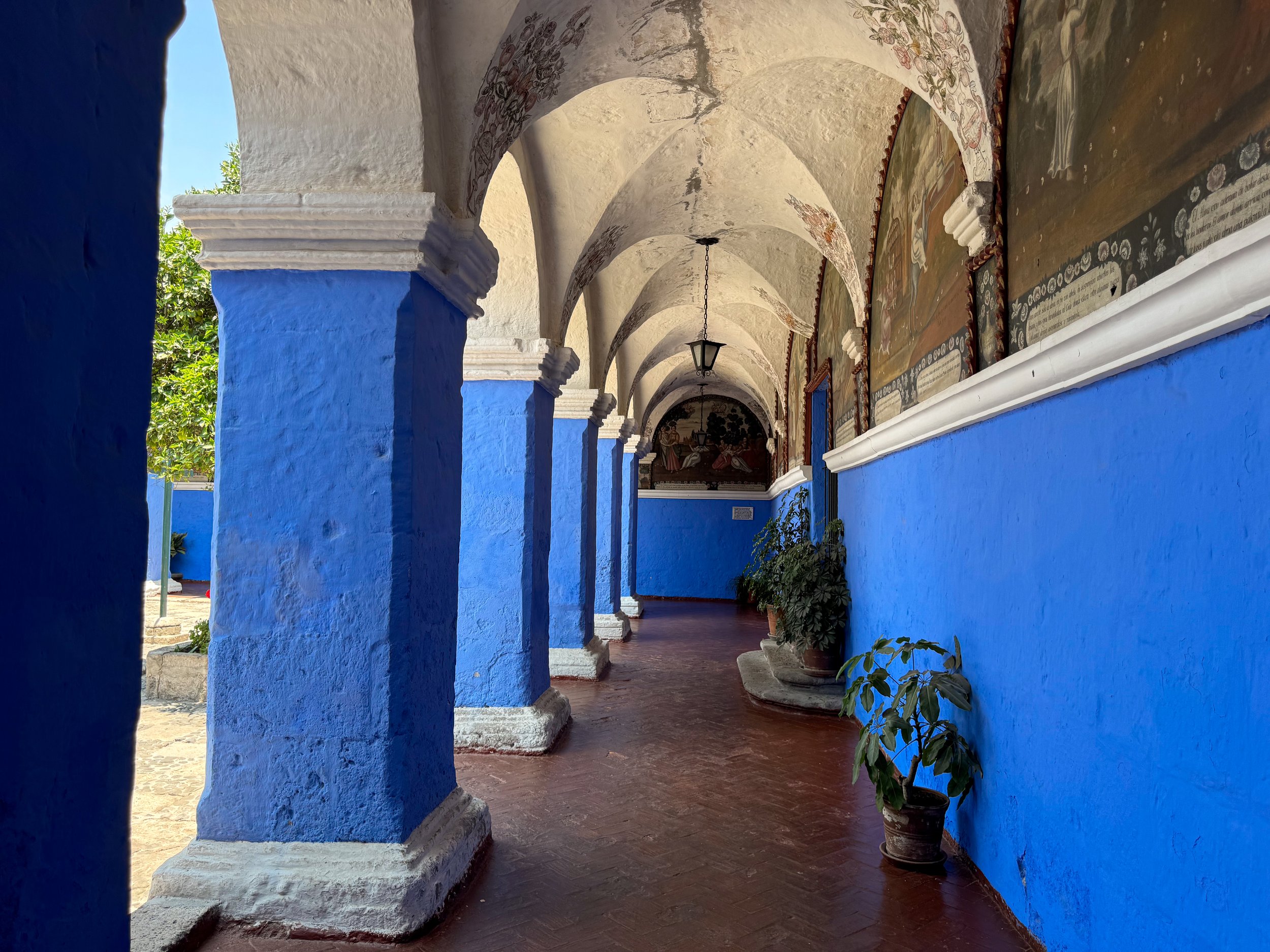
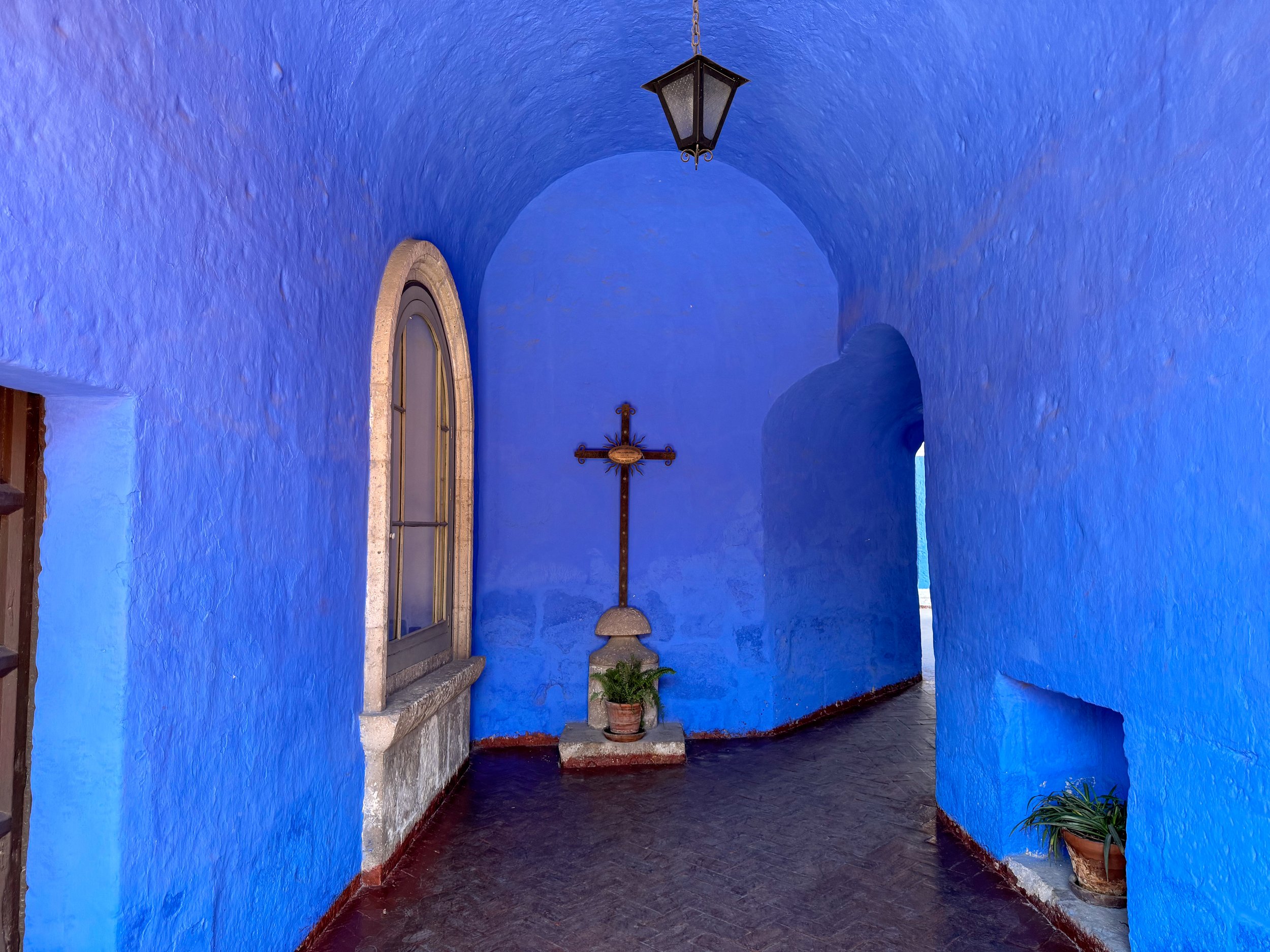
Santa Catalina Monastery. This large colonial monastery is a city within in a city surrounded by a stone wall. It’s defined by its maze of narrow cobblestone streets with their own names and vibrantly painted red walls. Branching off of the streets are individual homes for the nuns, blue painted cloisters, chapels with religious artwork and lush courtyards including one where we stopped for an afternoon wine.
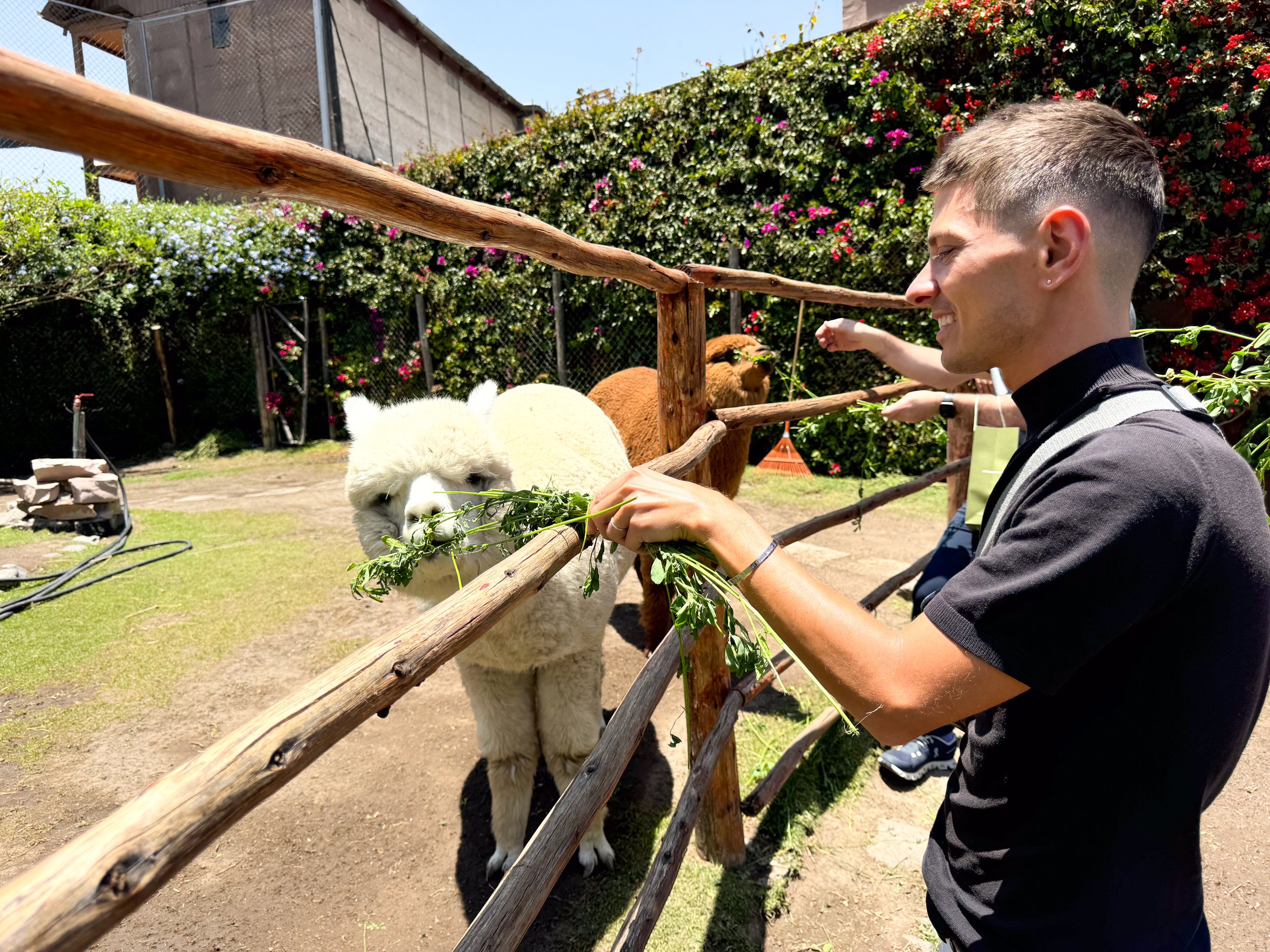
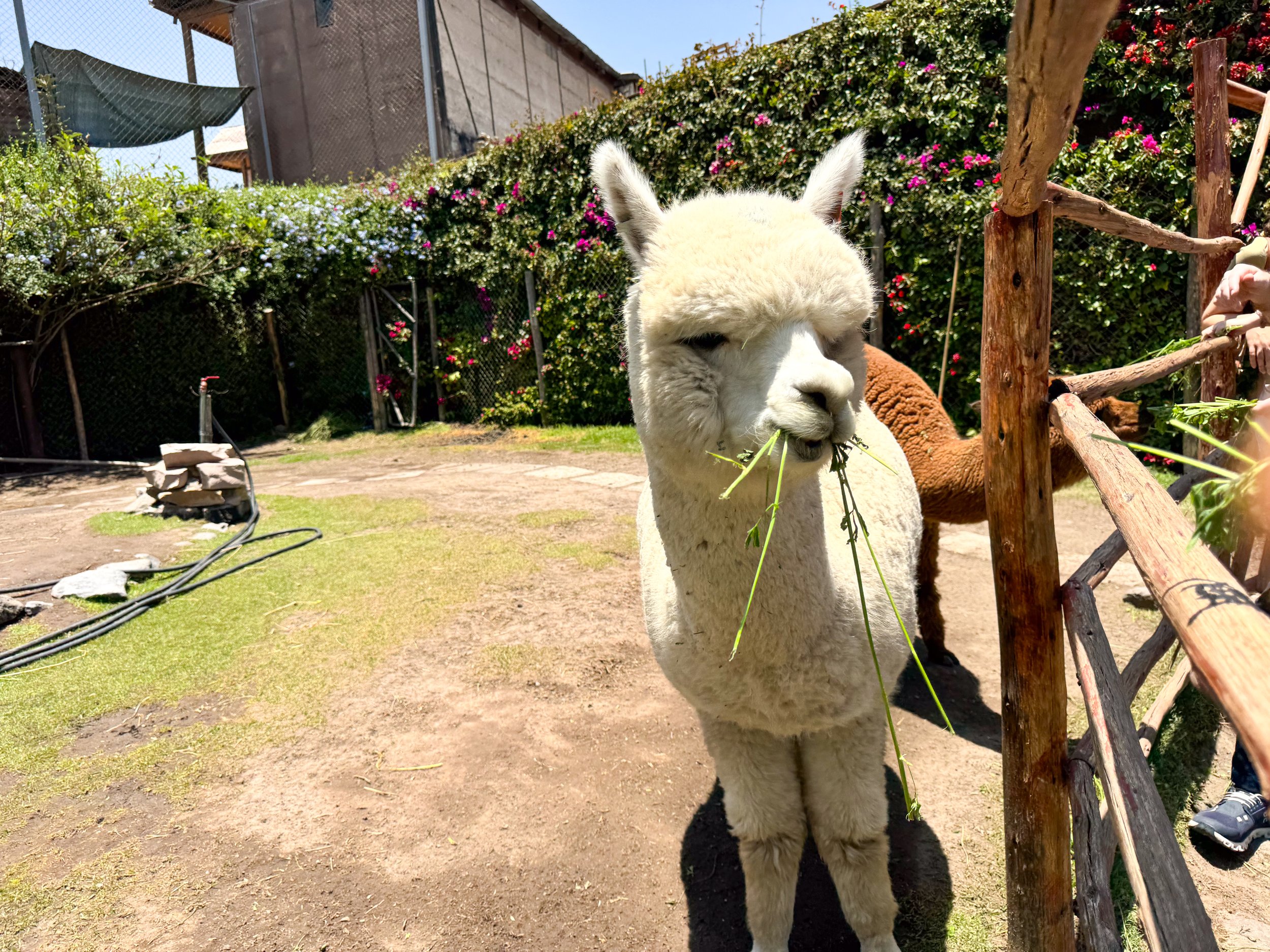
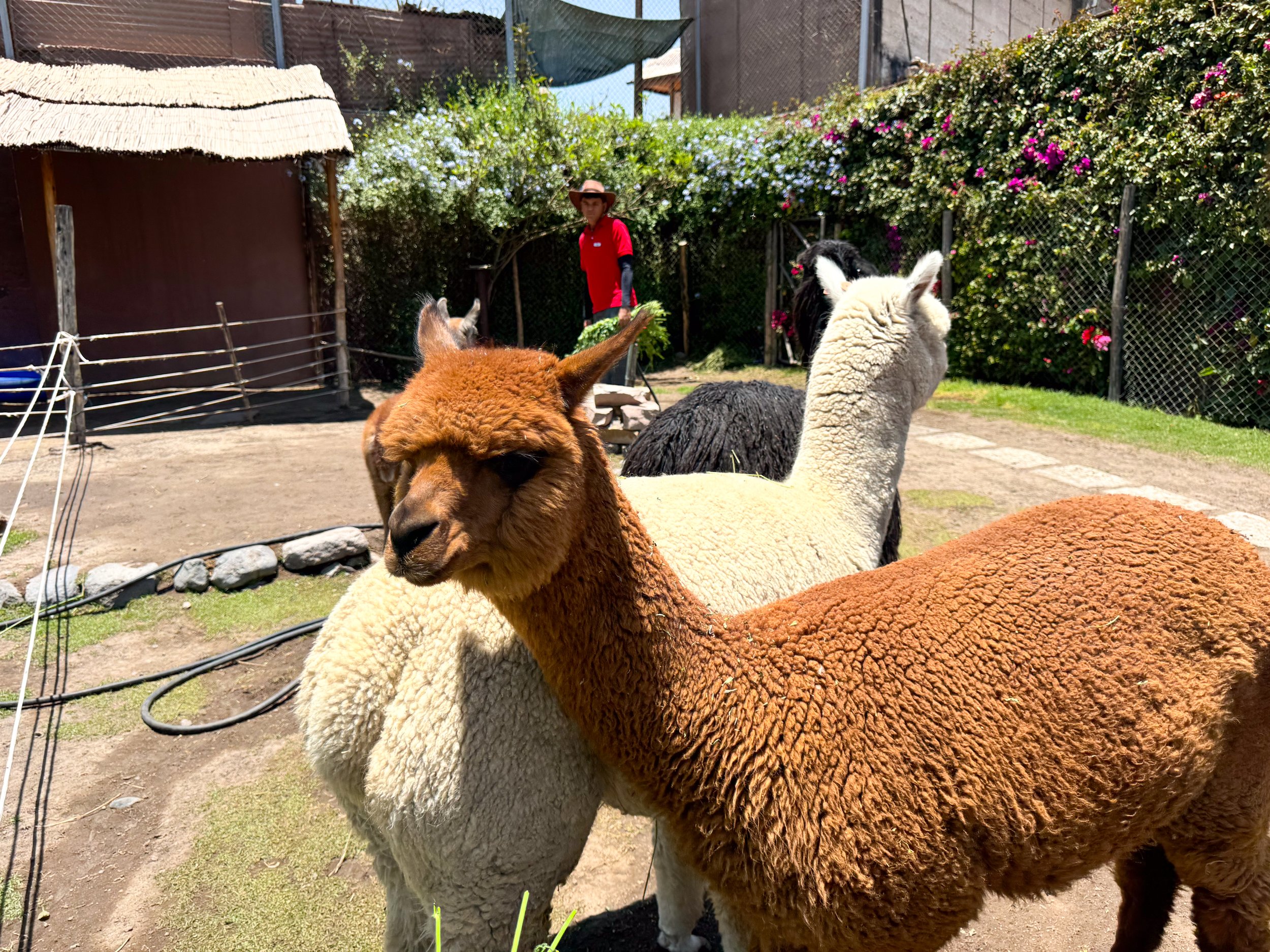
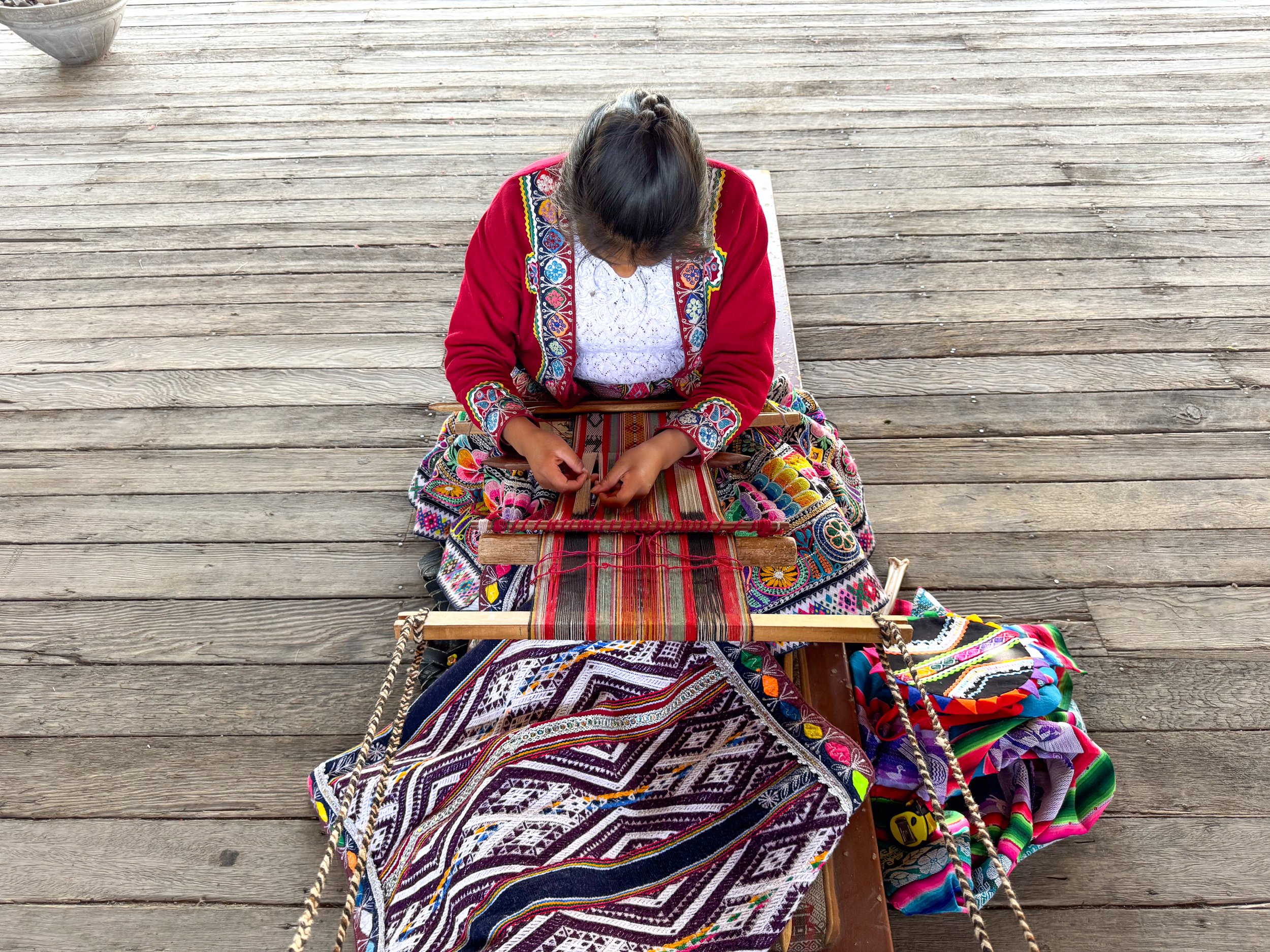

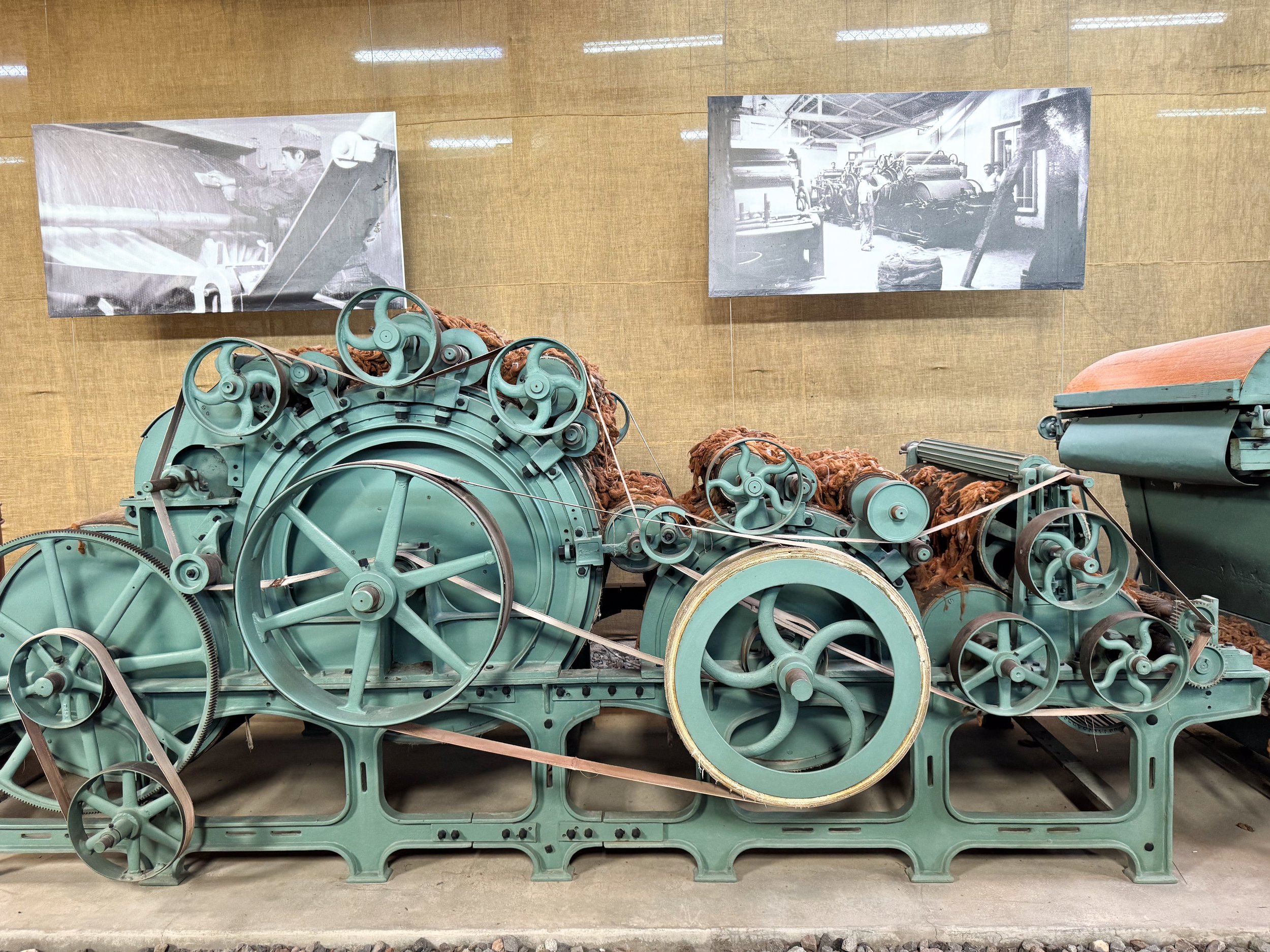
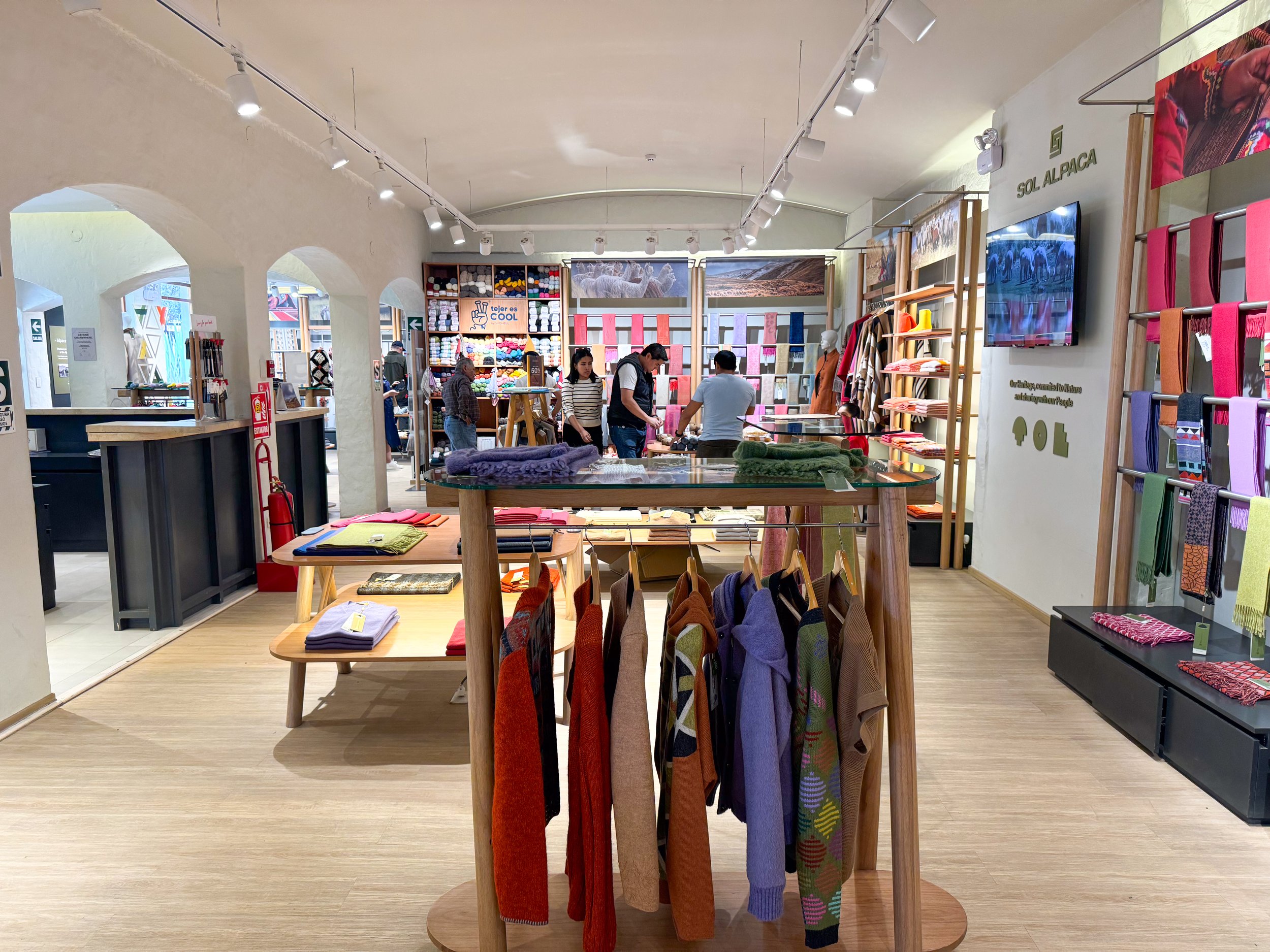
Museums
Mundo Alpaca. A free museum dedicated to llamas, alpacas and vicuñas, the cultural and historic importance of their wool, the artistry used in transforming it into vibrant textiles. We came here to see and feed the animals, watch a woman hand sorting the wool fibers, observe indigenous women hand weaving beautiful blankets using indigenous methods.
MUCEN Arequipa. A small museum in a historic building with a collection of Peruvian pottery organized by period of time, civilization and geographic regions across the country. Separate galleries display Arequipa style religious artwork and early forms of Peruvian currency. The museum is free to enter.
Where to Shop
Arequipa is a hub for Peruvian alpaca and vicuñas textiles, clothing and accessories including ponchos, sweaters, hats, gloves, blankets and yarn. We shopped at high end clothing stores, artisan markets and souvenir style shops. The higher end shops offered seasonal discounts ranging from 10-40% off while prices were negotiable at the artisan markets, souvenir style shops.
Sol Alpaca. A higher end shop with finer grades of alpaca and vicuñas wool clothing and accessories made with modern designs and patterns. We bought a poncho and hat.
Carasco Company. A historic hat maker that sells traditional Peruvian style hats made from alpaca fibers. I bought a blue wool hat with a yellow band.
Qori Kancha. A shop that sells lesser grade alpaca wool clothing and accessories made with traditional designs and patterns. I bought a blue and red traditional style poncho with a geometric pattern from here.
Festival Artesanal Productores Arequipenos. A popup market near the Plaza de Armas with tents of local artisans knitting and selling alpaca fiber clothing and accessories. I bought a sweater with the design of a vicuña embroidered on it.
Fundo El Fierro Arequipa. An artisan craft market in the alley way, plaza and market surrounding the Plaza de San Francisco. Come here for all manner of alpaca products, handmade items, gifts and souvenirs.
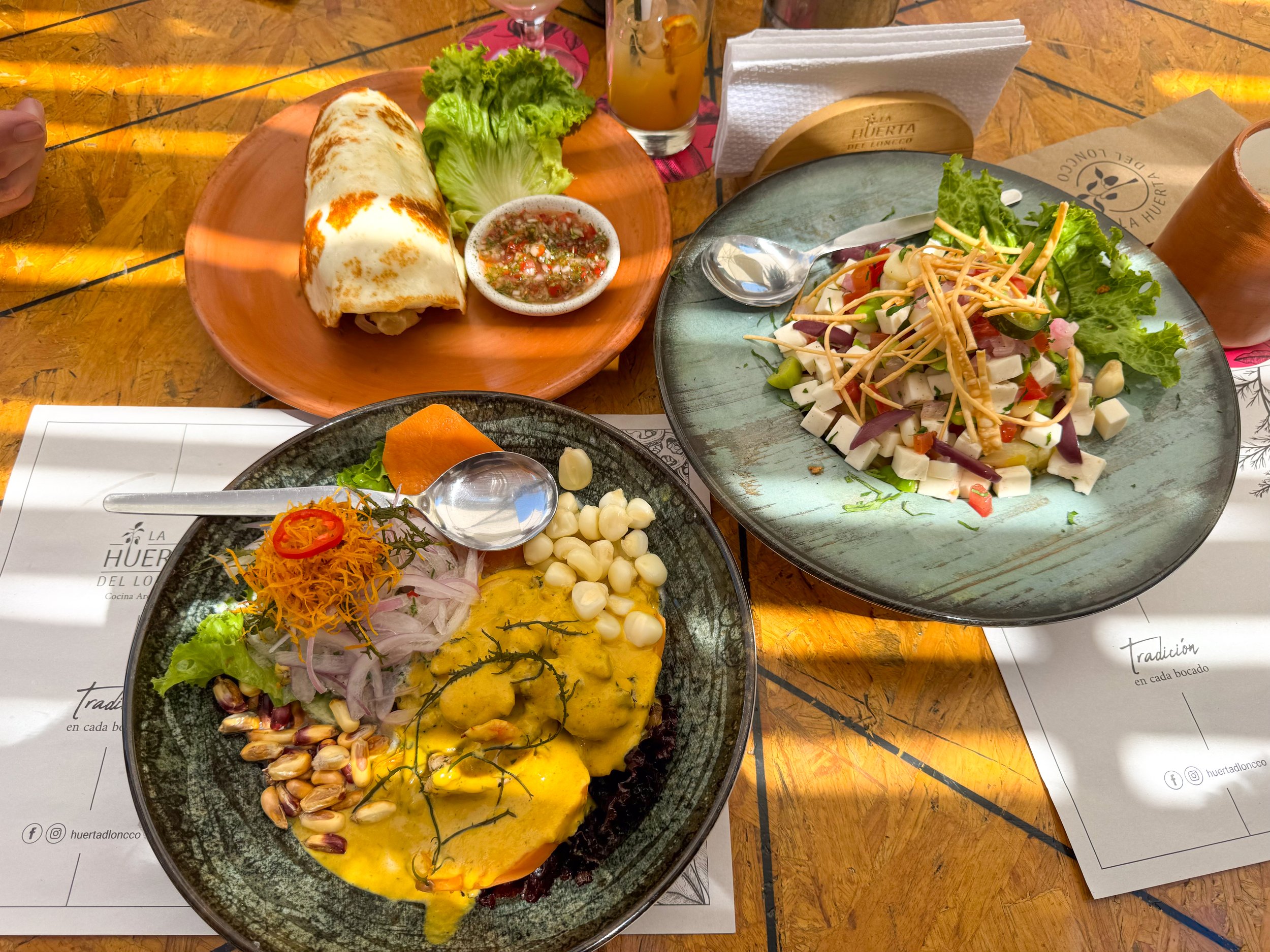
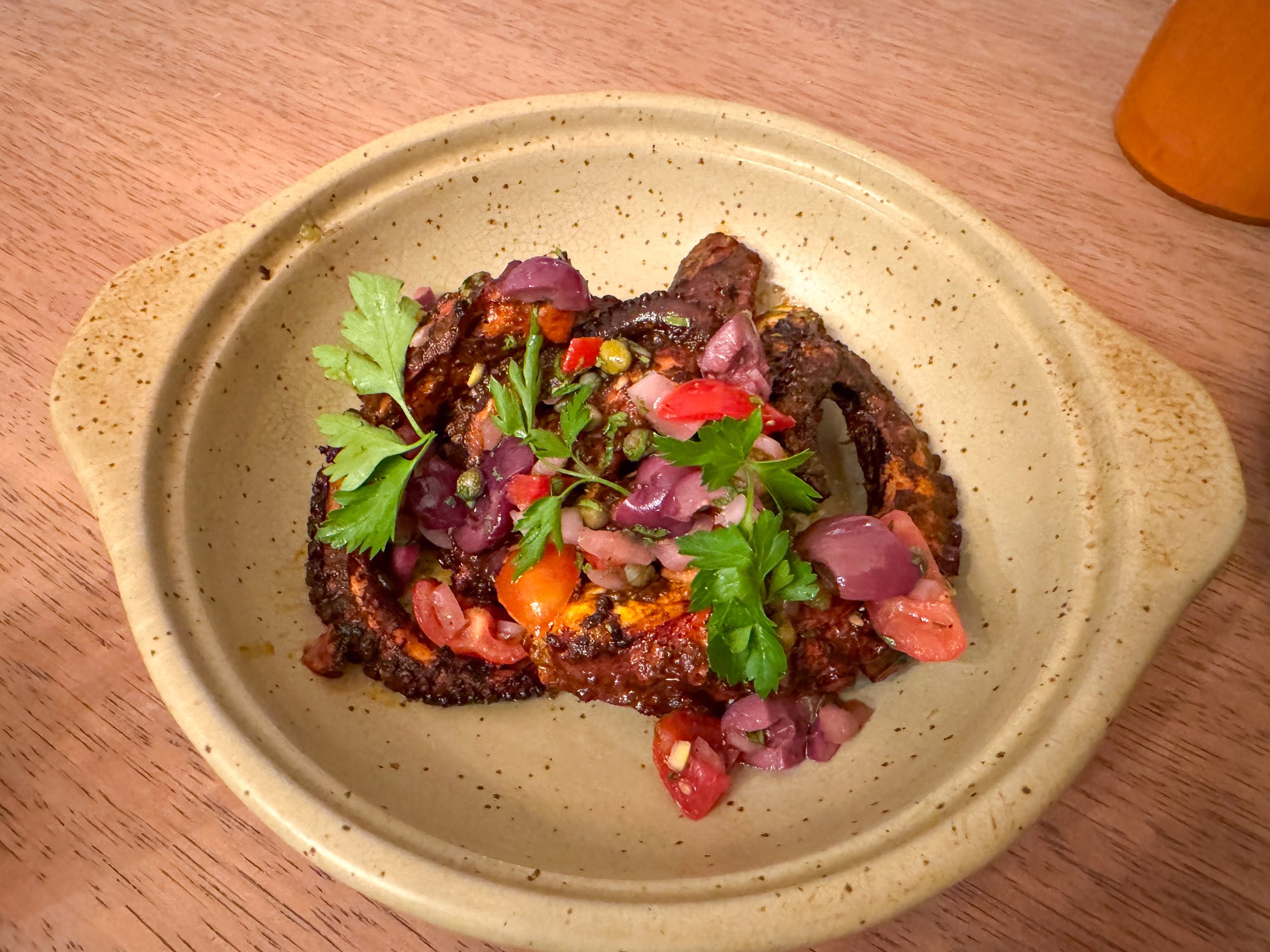
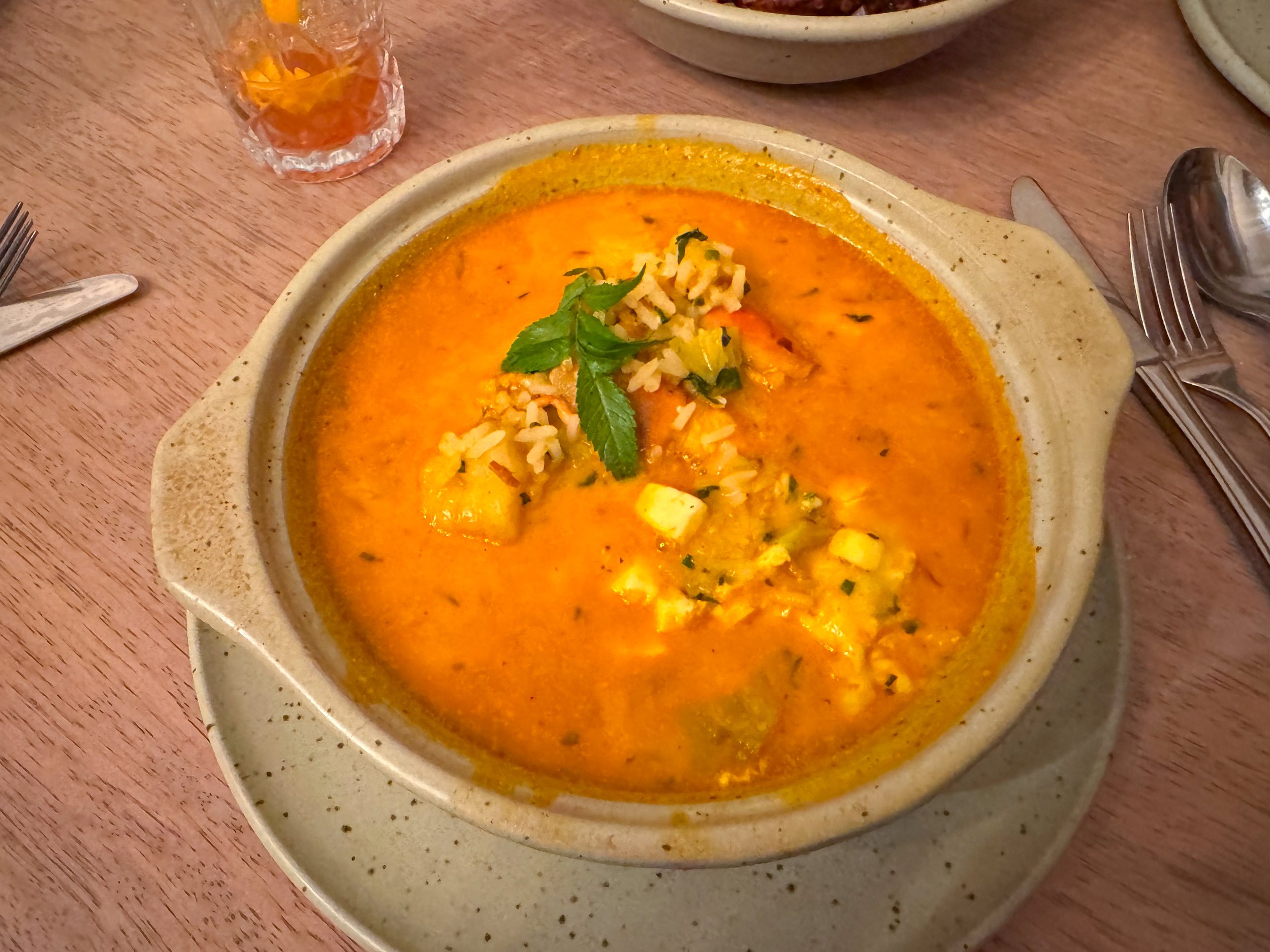
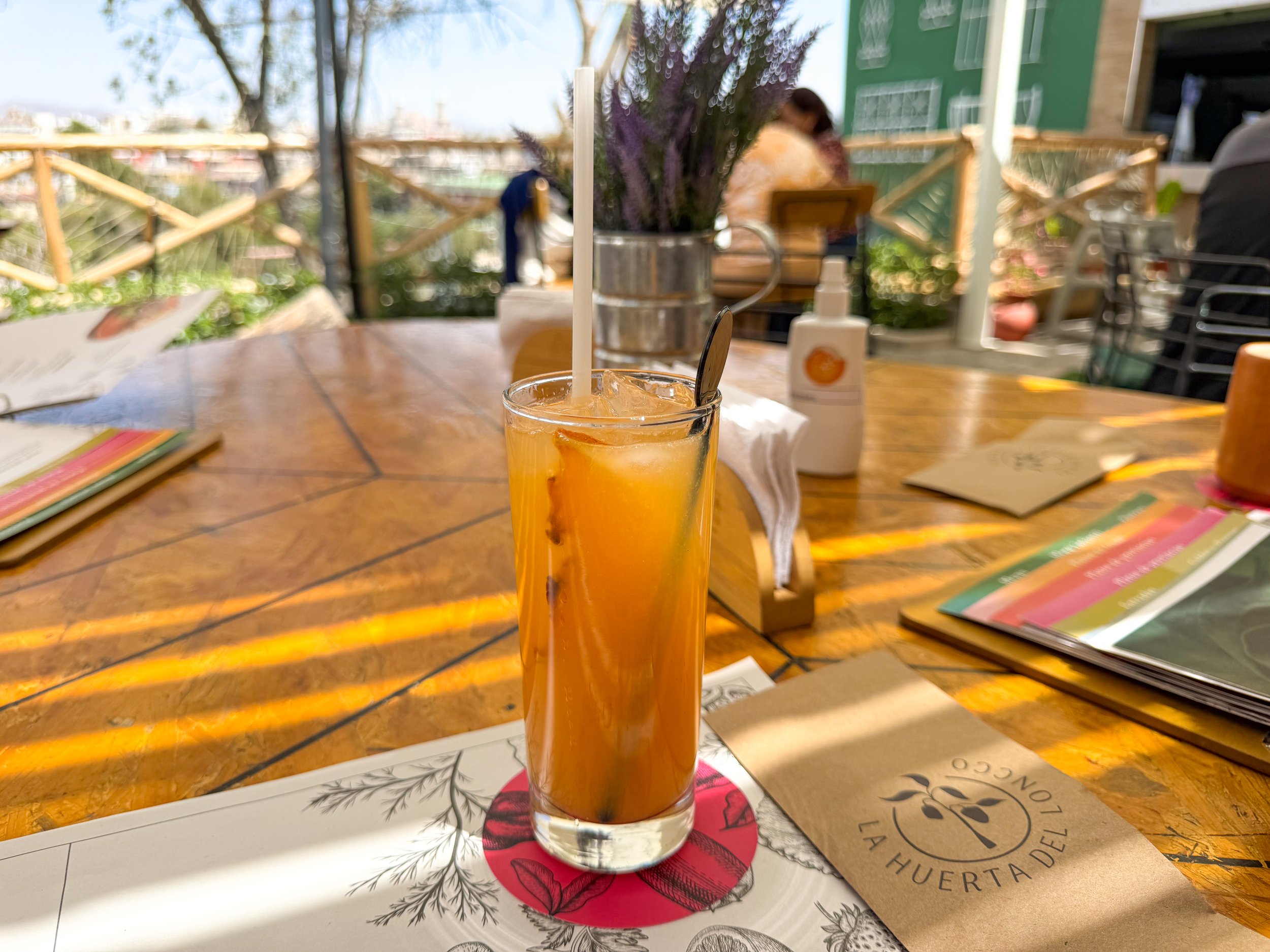
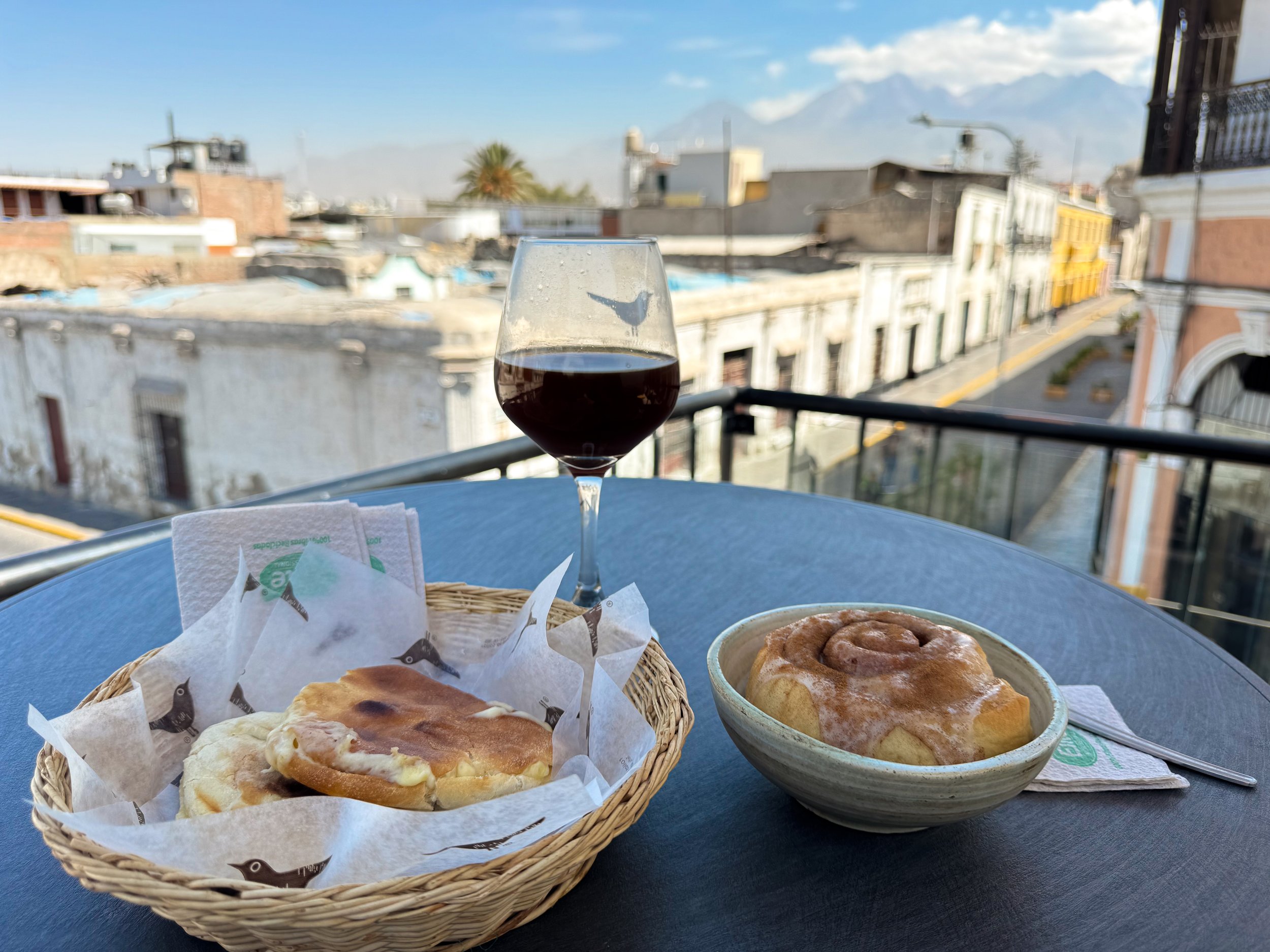
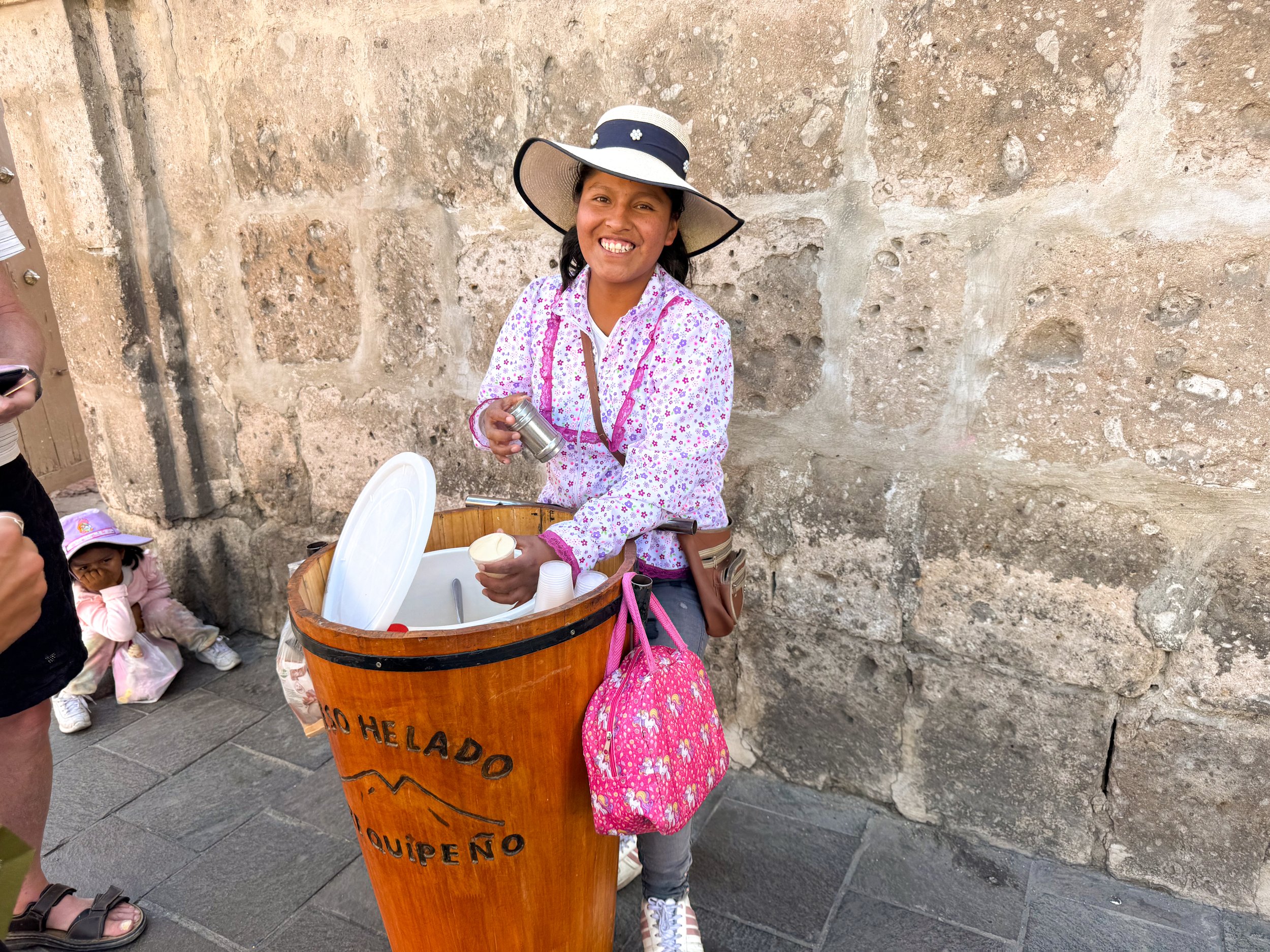
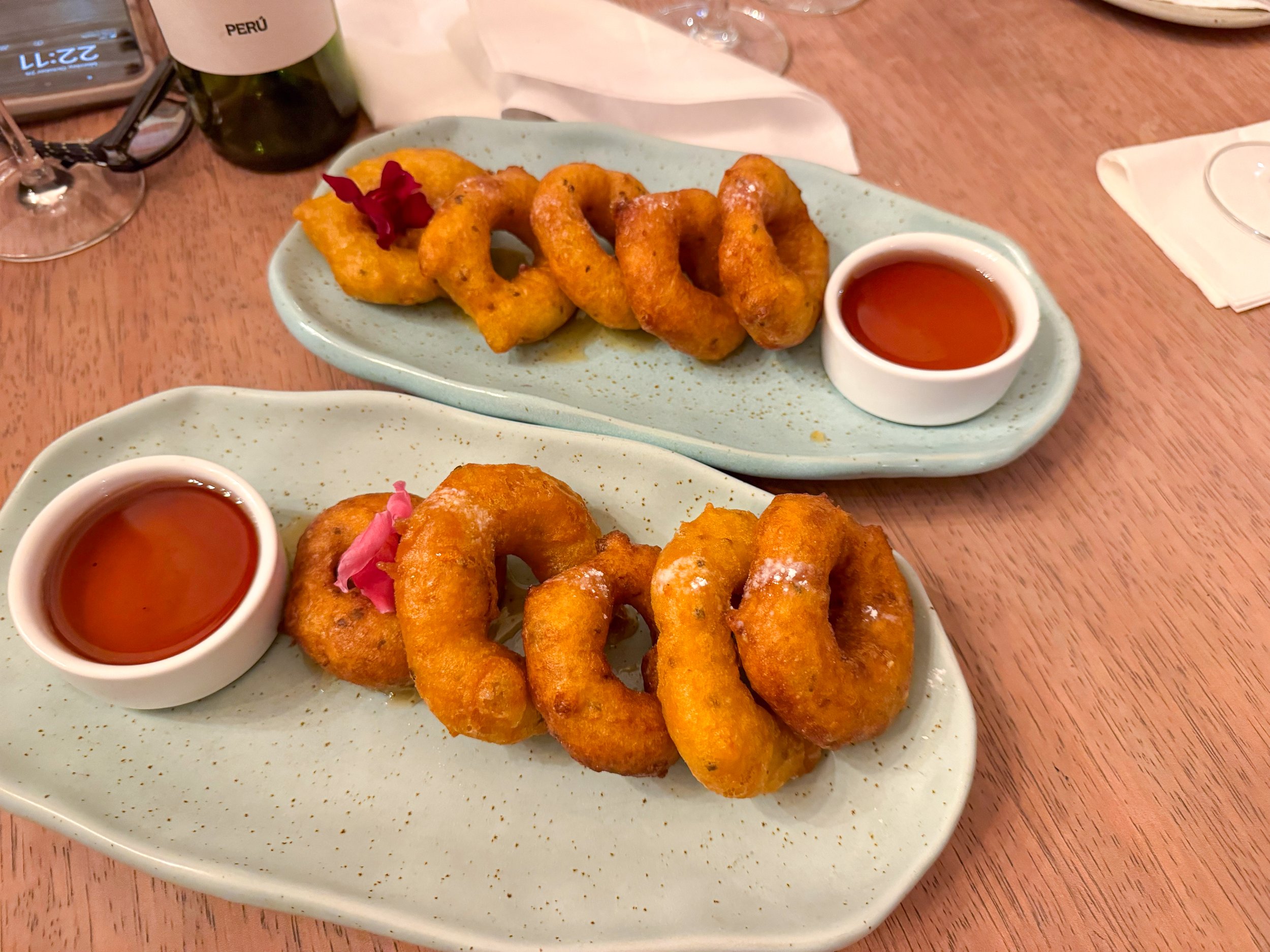
Arequipa Cuisine
Arequipa is recognized as a gastronomic hub for its cuisine and cultural significance in Peru. While here, we shopped and ate at the local market, dined at picantereas, tasted the street food and enjoyed rooftop cafes and bars.
Picantereas. A type of restaurant local to Arequipa known for spicy food.
Chupe de Camarones. A shrimp stew with potatoes and rice cooked in a spicy and creamy broth. It’s a popular dish local to Arequipa and sold at picantereas across the city.
Tantawawa. A Peruvian bread made specifically for Dia de los Muertos. It’s a spiced brioche style loaf commonly braided into the shape of a swaddled infant, llama or basket decorated in sesame seeds and colorful sprinkles.
Queso Helado. An ice-cream made from local cheese. It’s commonly sold by the cup on the street.
Choclo con Queso. Boiled Peruvian corn wrapped in a grilled piece of Peruvian cheese.
Alpaca & Guinea Pig. We don’t eat meat however we saw both animal on the menu in restaurants across the city. Alpaca can be served as a steak while guinea pigs are often served whole.
Picarones. A fried potato based donut served with honey.
Ocopa Sauce. A yellow creamy sauce made from peppers, cilantro and cheese. It’s often used to cover potato and meat dishes.
Chicha. A fermented drink made from purple corn. It was popular during the Incan times and is still drank today by itself or as an ingredient in cocktails.
Cusquena. One of Peru’s national beers easily identifiable by its bottle cap with Machu Picchu on it and a bottle embossed in Incan stone work. It comes in three varieties, Dorado (Golden), Wheat and Negro (Stout).
Chilcano. A Peruvian cocktail made with Pisco, lime juice and ginger ale. We ordered the traditional version and one with passion fruit multiple times, even making our own using this recipe.
2.5 oz Pisco (plain or with passion fruit)
0.5 oz Fresh lime juice
12 oz Ginger ale
2 dashes Angostura bitters
Stir together with ice
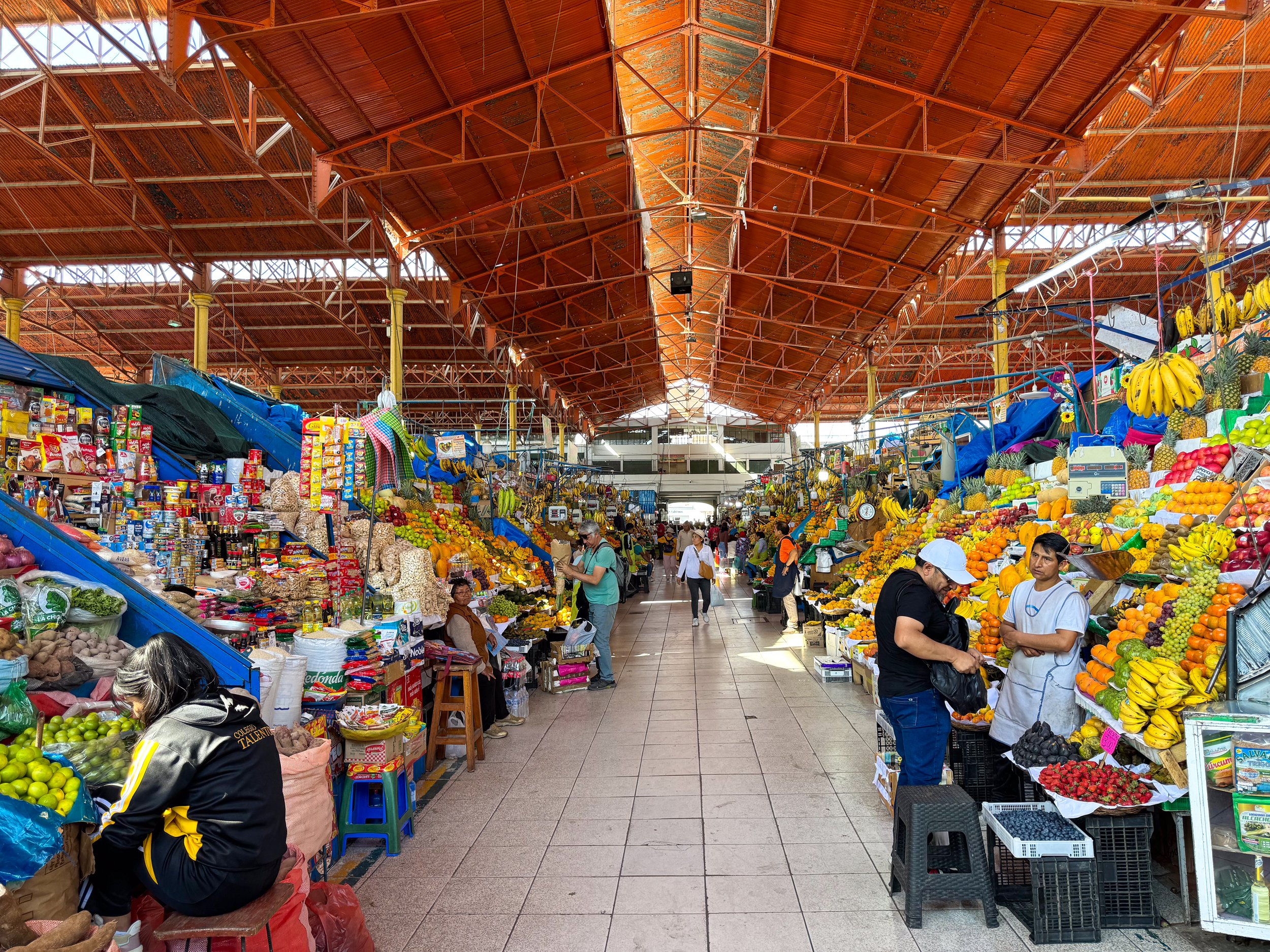
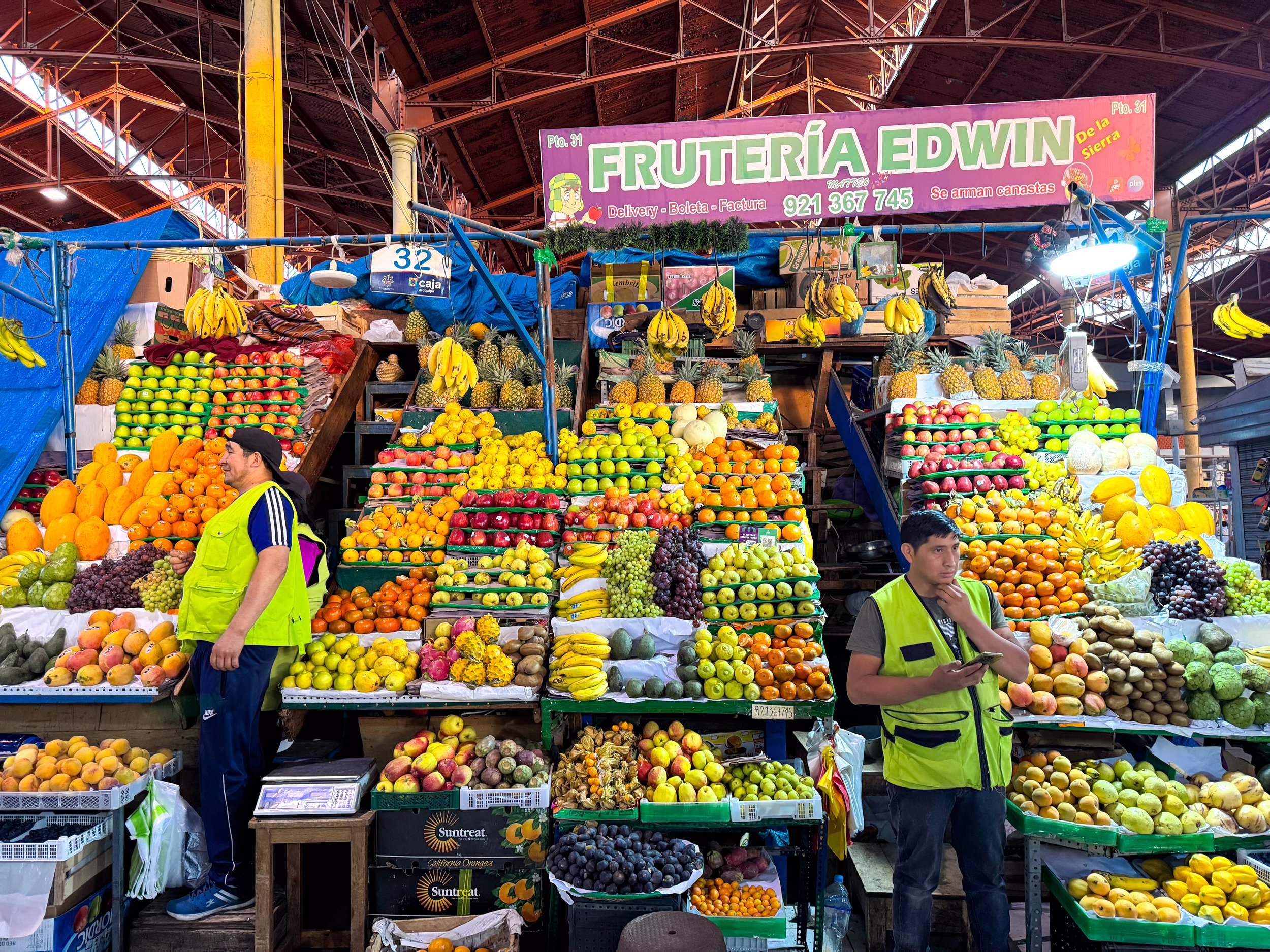
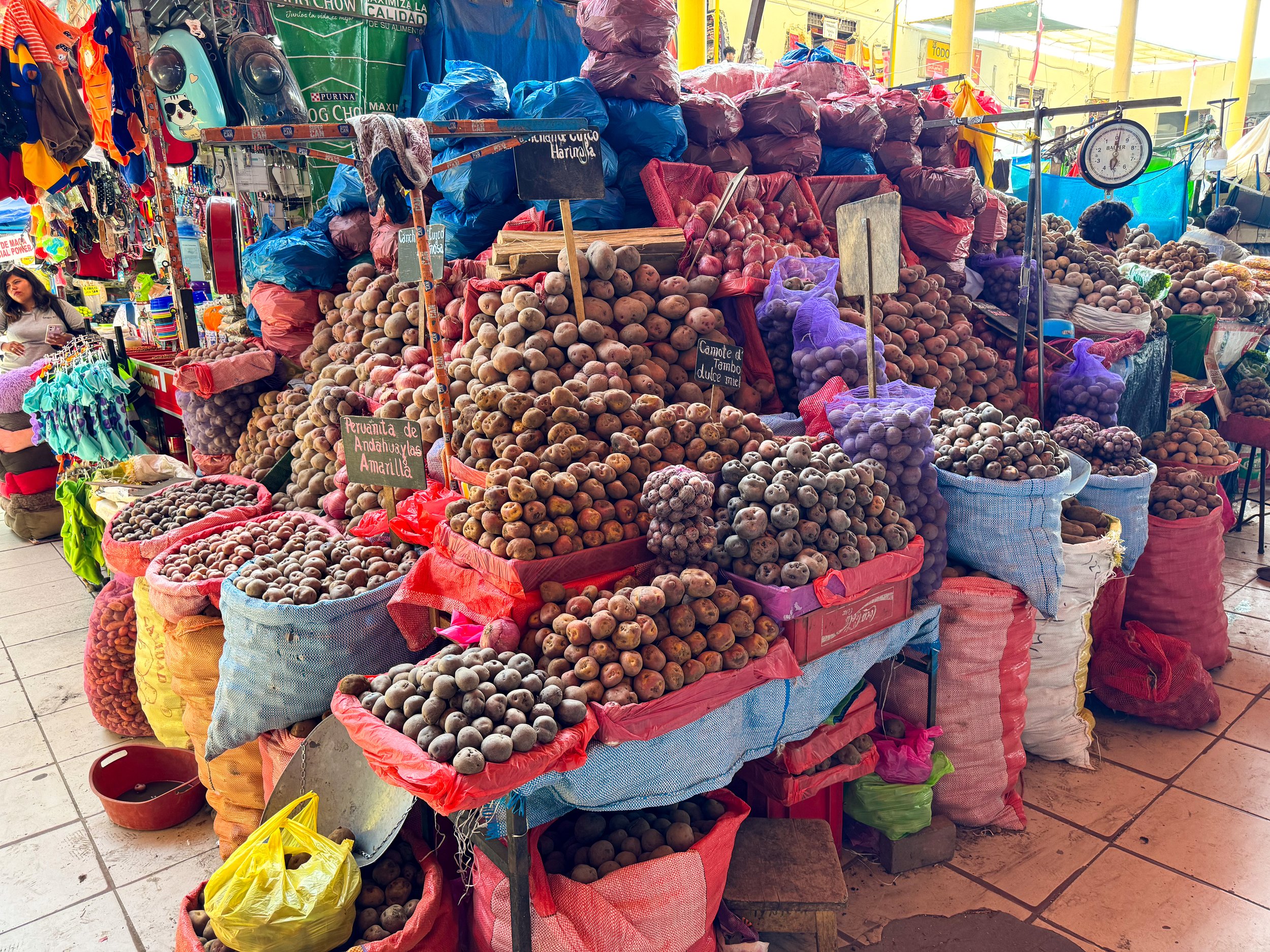
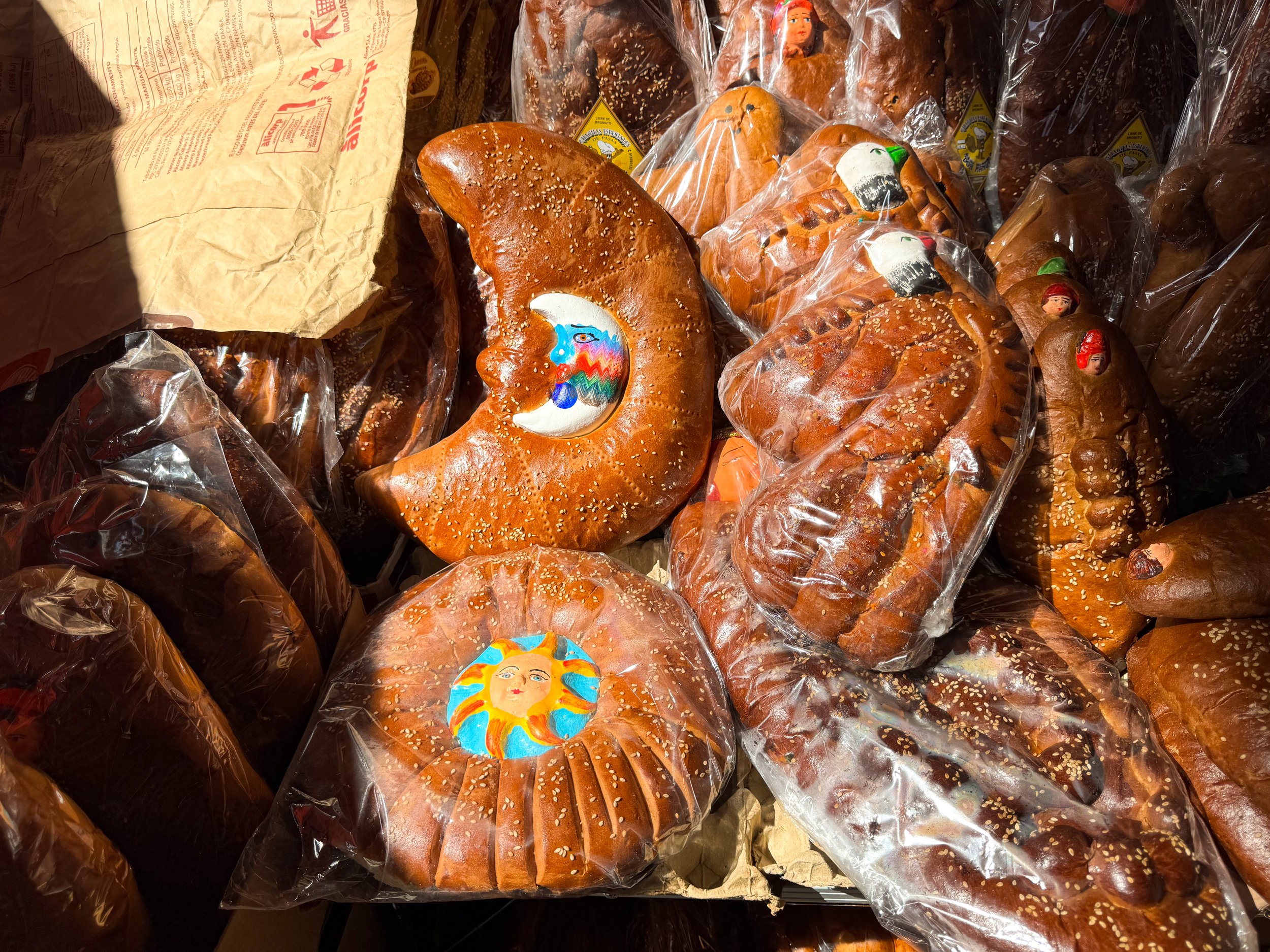
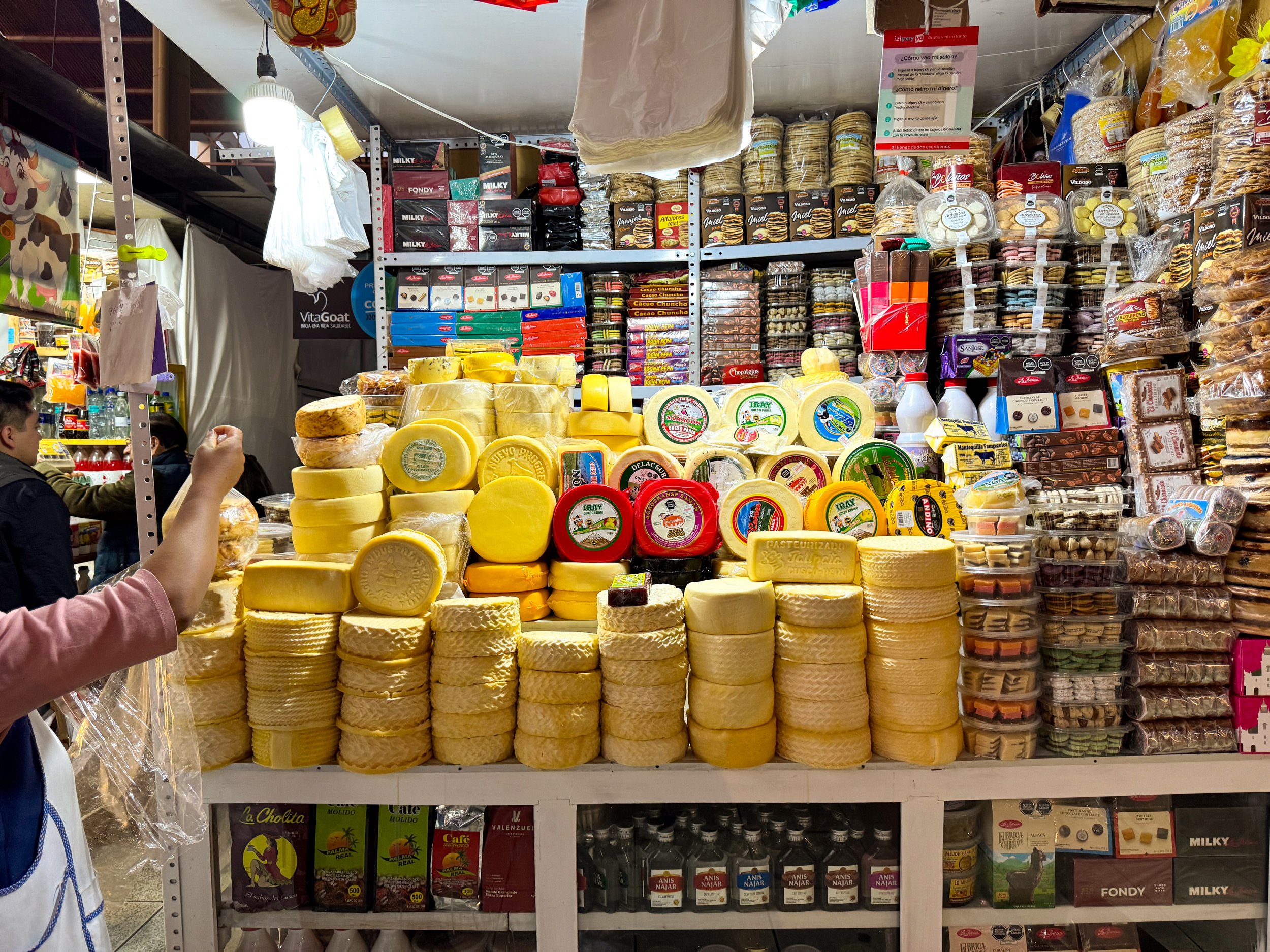
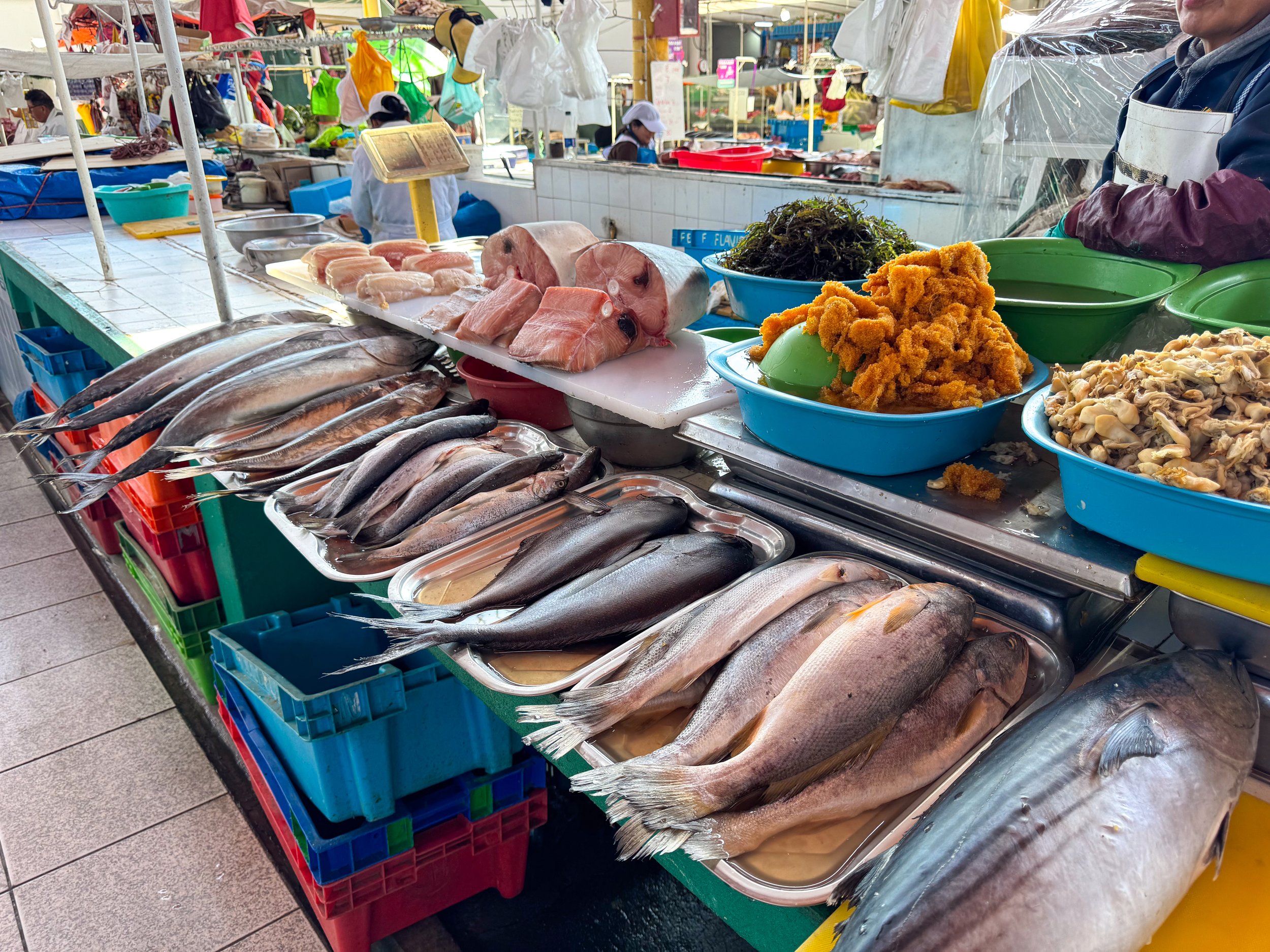
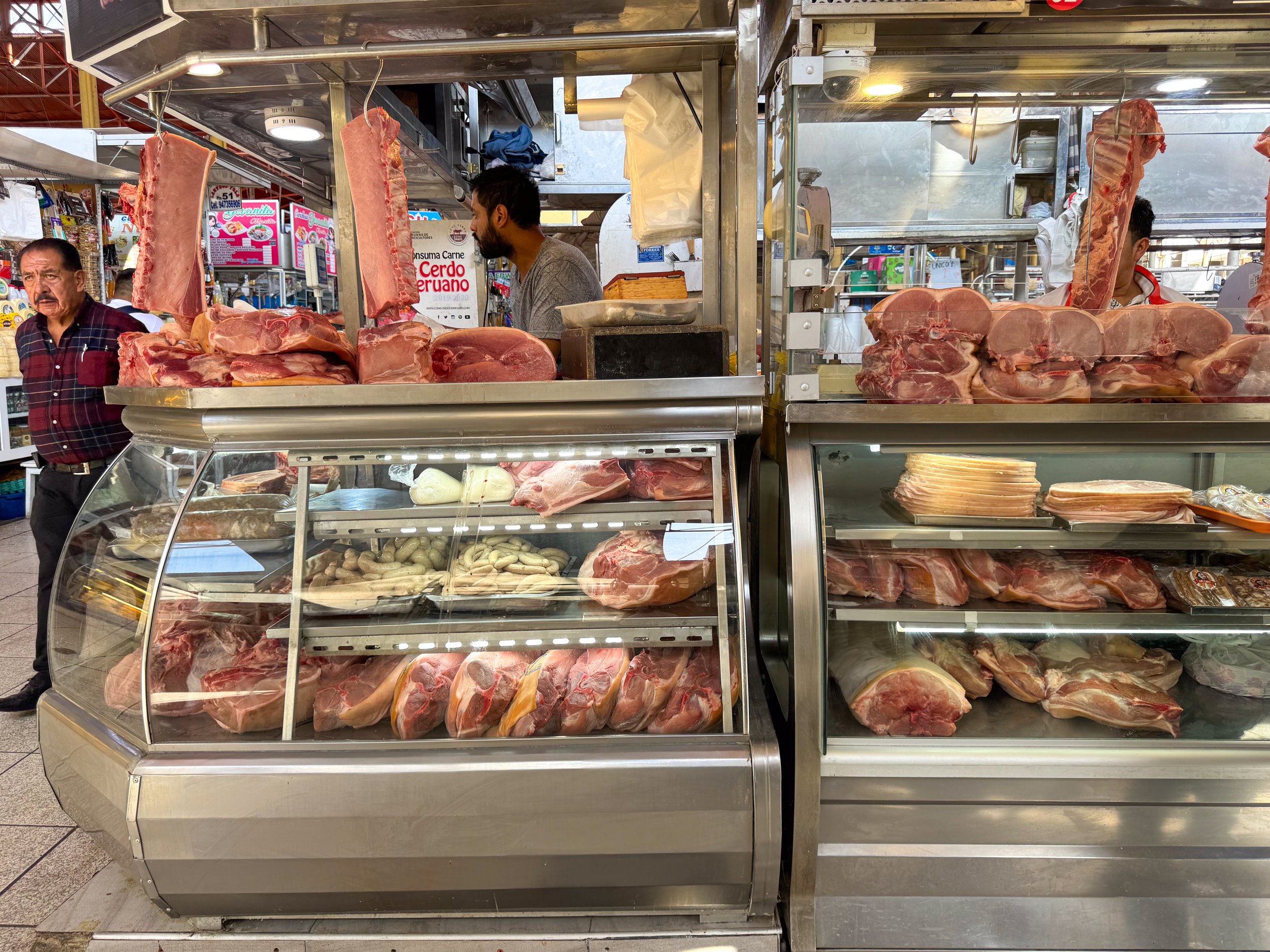
San Camilo Market. A central market with vendors selling selling fruit from towering shelves, baskets filled with potatoes, wheels of Peruvian cheese, aisles of freshly butchered with meat and fish, pillowy breads, purple and yellow chicha, bins of coca leaves and rows of textiles. We left with a bag of breads and fruits including dragonfruit, chermoya, pepinos melones, avocado and blueberries.
Another reason to visit the market is for the street food and inexpensive lunches. We bought potato salteñas and empanadas from a vendor outside of the market and sat down at one of the restaurants inside for pescado frito con arroz verde and a cusquena, only spending 10 Sol per plate.
Where to Eat and Drink
Chicha por Gaston Acurio. An elegant restaurant with a warm terracotta colored interior lined with Peruvian clay pots and suspended basket lights. The menu includes traditional Peruvian cuisine like guinea pig and alpaca dishes, purple corn (chicha) different types of ceviche, chupe de camaron, picarones, Peruvian wine and cocktails like the pisco sour and chilcano. We came here with friends to celebrate Devin’s 30th birthday!
La Huerta del Loncco. A lunch spot with contemporary Peruvian dishes and a shaded outdoor patio overlooking the city. We ordered the choclo con queso, ceviche, potatoes and grilled seafood in ocopa sauce and queso salad.
Dimas Restaurante. A charming restaurant inside a vaulted white volcanic stone dining room with a range of Peruvian and international dishes. We shared the brocoli cream soup and tuna tartare made with avocado, mango and passion fruit.
Zig Zag Restaurant. A restaurant that specializes in meat dishes and wines. We came here to enjoy a carafe of sangria before dinner in their historic dining room built from white volcanic stones and a wrought iron spiral staircase designed by Gustave Eiffel.
Puku Puku Arequipa. A rooftop cafe with views of the mountains and volcanos. We came here in the morning for breakfast pasties and ordered Peruvian roasted coffee brewed in a French press and Chemex. They also offer coffee brewed by Aeropress or espresso carafe.
Amaray. A cafe and restaurant on the second floor of an arched building overlooking the Plaza de Armas and Basilica of Arequipa.
Museo del Pisco. A Pisco bar in a historic building made from Arequipa’s iconic white stones. Come here to order Pisco cocktails, taste various types of Pisco or join mixology class.
Zingaro Wine Bar. A wine bar and shop with Peruvian wines. We bought and shared multiple bottles from here including Vittoria Reserva Malbec from the Valle de Ica, Peru and Intipalka Vino Cabernet Sauvignon Syrah Réserva from the Valle de Sol, Peru.
Sunset Rooftop Bar. A rooftop bar at the Le Foyer Hotel with views of the sunset, city, mountains and volcanos. We came here for smoked chicha and Pisco cocktails.
Where to Stay
We stayed at two accommodations during our time in Arequipa. One Airbnb and a boutique hotel
Historic Airbnb. A spacious rental unit in a white volcanic stone and arched room. The public spaces included a living room, luggage lockers and kitchen.
Le Foyer Arequipa. A boutique hotel with simple rooms, luggage store and a rooftop bar.
Katari Hotel At Plaza De Armas. A luxury hotel in the central plaza with beautifully decorated rooms and a roof top restaurant. We visited a friend that was staying here.
Good to Know
Sand Flies. An insect similar to mosquitos. They leave much larger welts after sucking blood. They were present in October and November in Arequipa.
Language. Spanish is the most common and widely spoken language. Few people speak English.
Cash vs Card. Both cash and card were widely accepted. Carry coins and small bills for street food and markets.
For next time…
Next time we visit Arequipa, we plan to venture out of the city and see some of the regions most impressive sights.
Reserva Nacional de Salinas y Aguada Blanca. A high altitude nature reserve home to vicuñas, alpaca and flamingos with a dry grassy landscape, mountains, volcanos, salt water lagoons and rivers. We drove through here on our way to Cusco spotting large groups of vicuñas, llamas and alpaca grazing in the dry grassy terrain as well as bright pink flamingos contrasted against the dark color of the mountain lagoons. Along the road, as we continued into the Andes, we passed through small towns with indigenous Peruvians dressed in colorful attire and freshly shaved llamas wearing coats.
Colca Canyon. The second deepest canyon in the world surrounded by steep mountains and snow covered volcanoes. We would love to visit to spot the condors, hike its trails, swim in the natural hot springs and raft in Colca River.
El Misti Volcano. The prominent conical shaped volcano seen from Arequipa. We would love to take an overnight hike to reach its summit at an elevation over 19,000 ft.




